The document is about the development of a Swift clone of the game '2048', detailing its architecture, game logic, and implementation. It explains how the game combines tiles based on user moves and tracks the state of each tile using action tokens. The document also covers the use of structs, enums, and the view layer for displaying game updates.
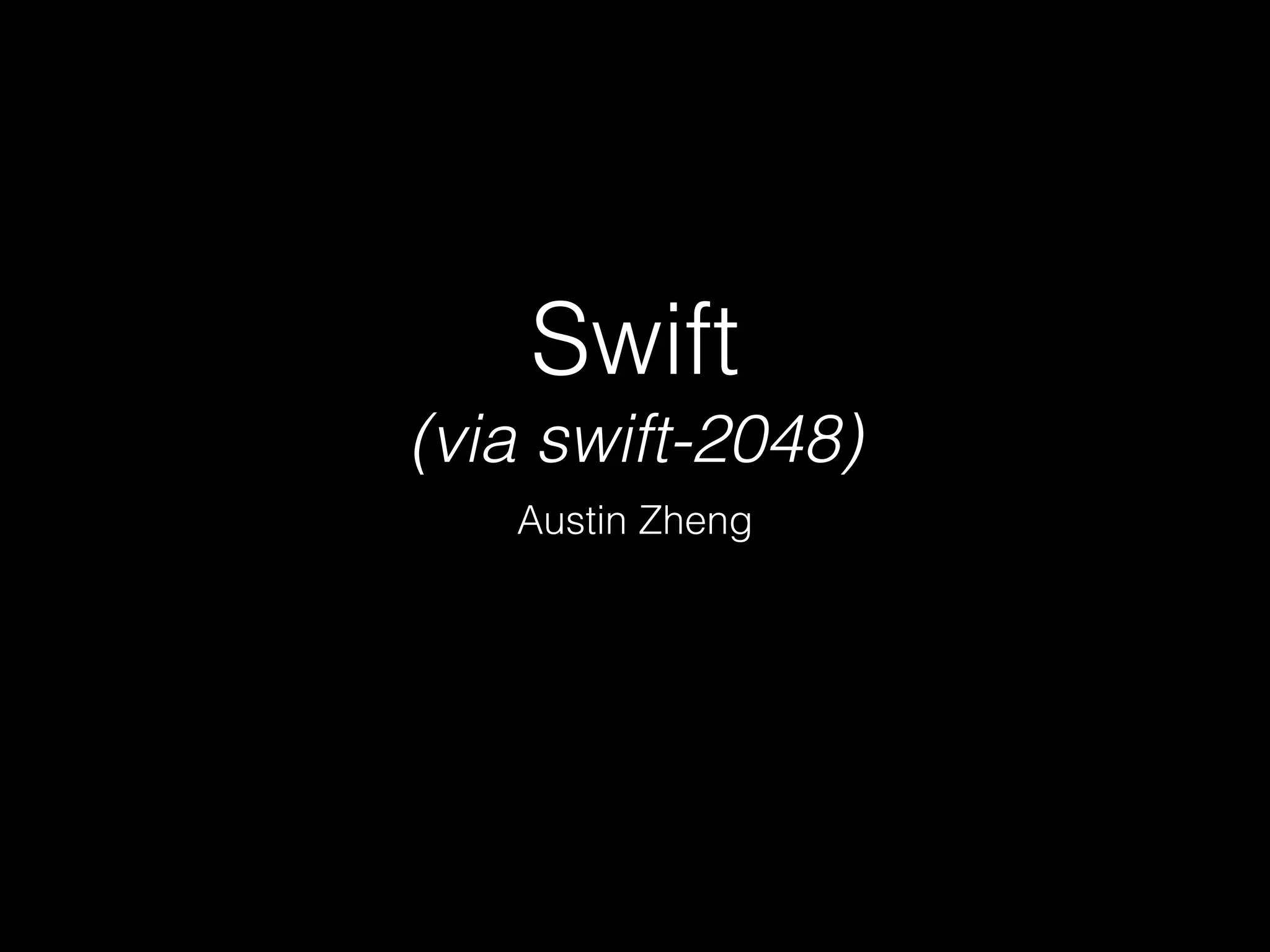
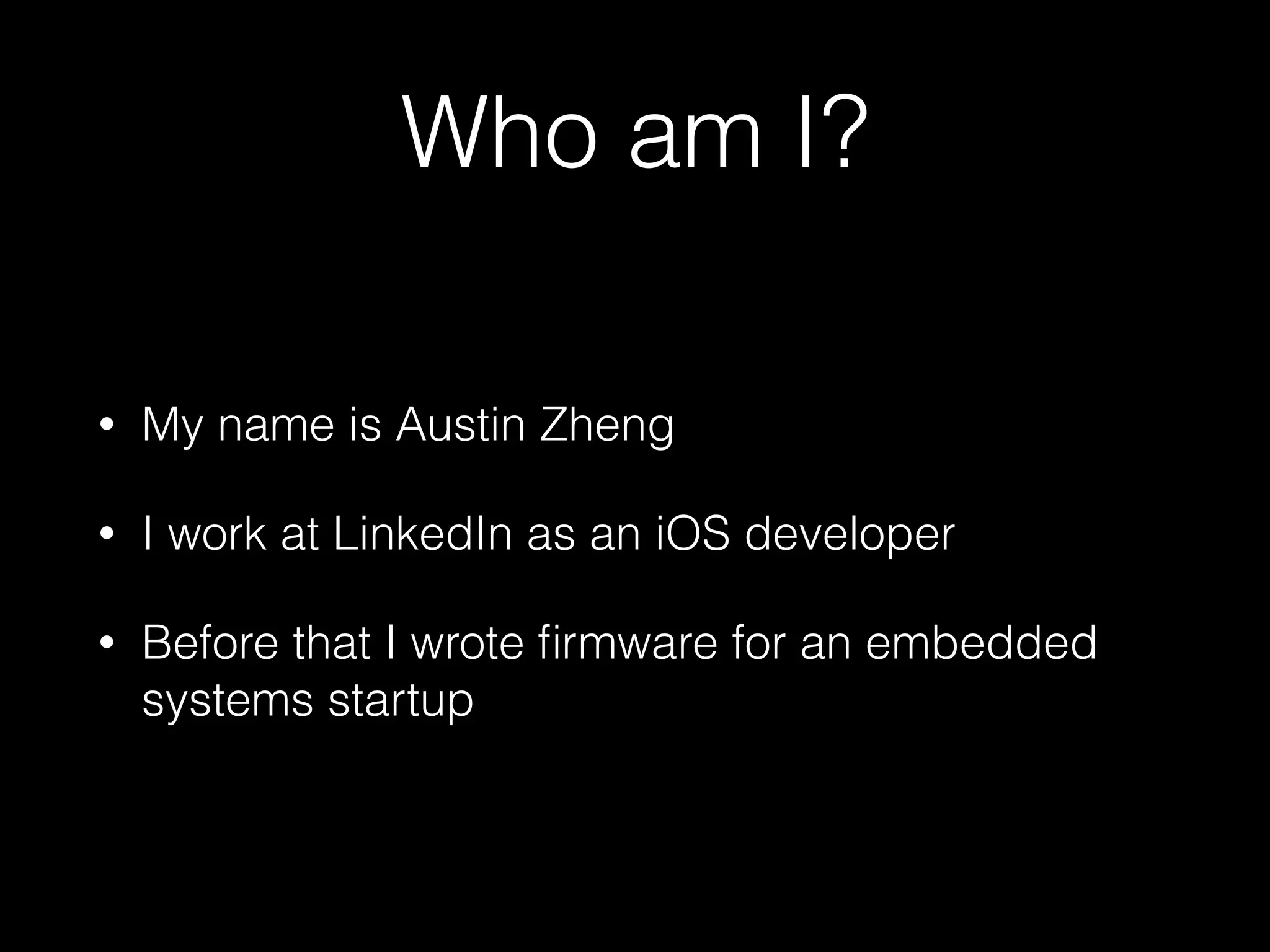
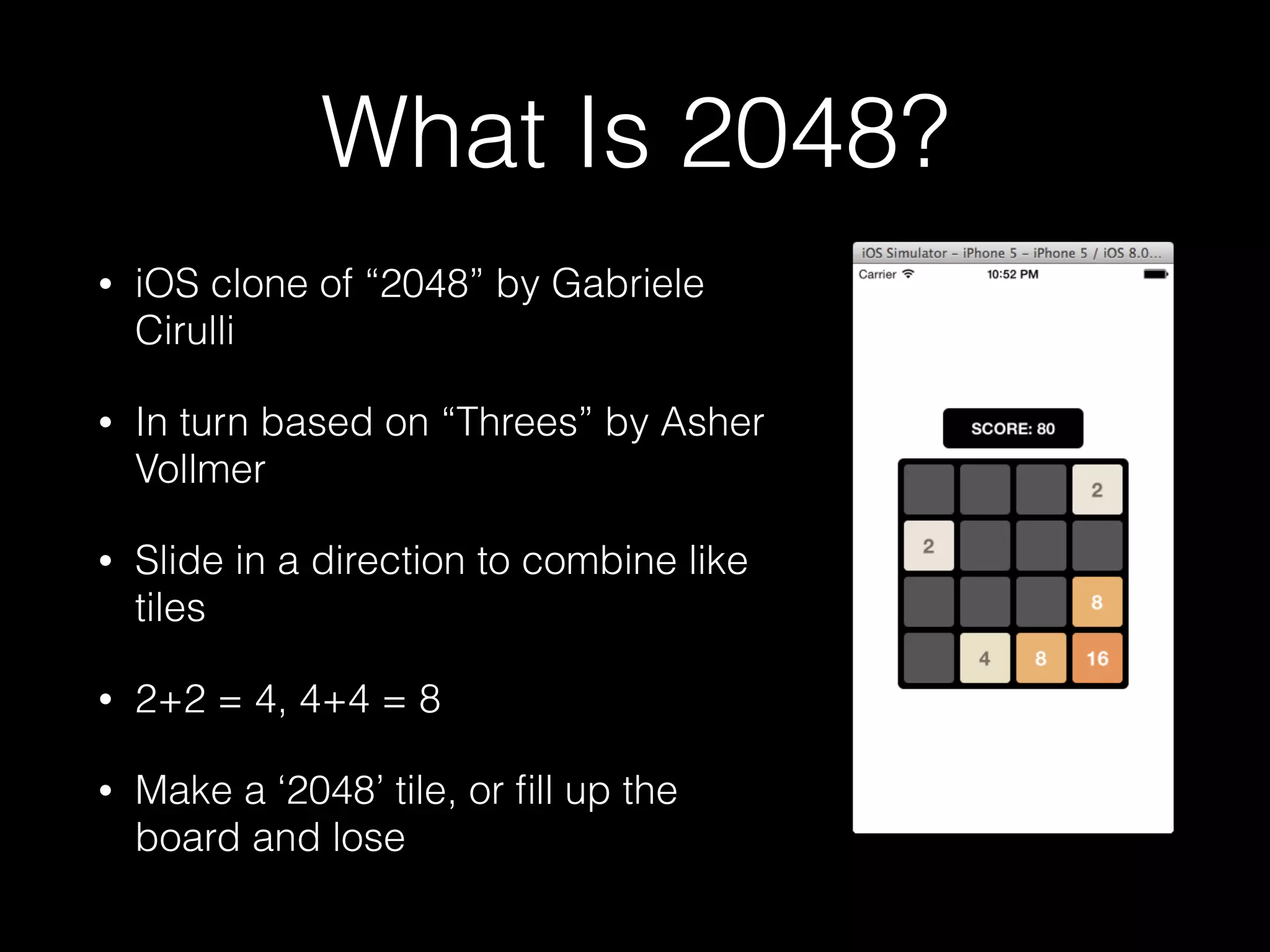
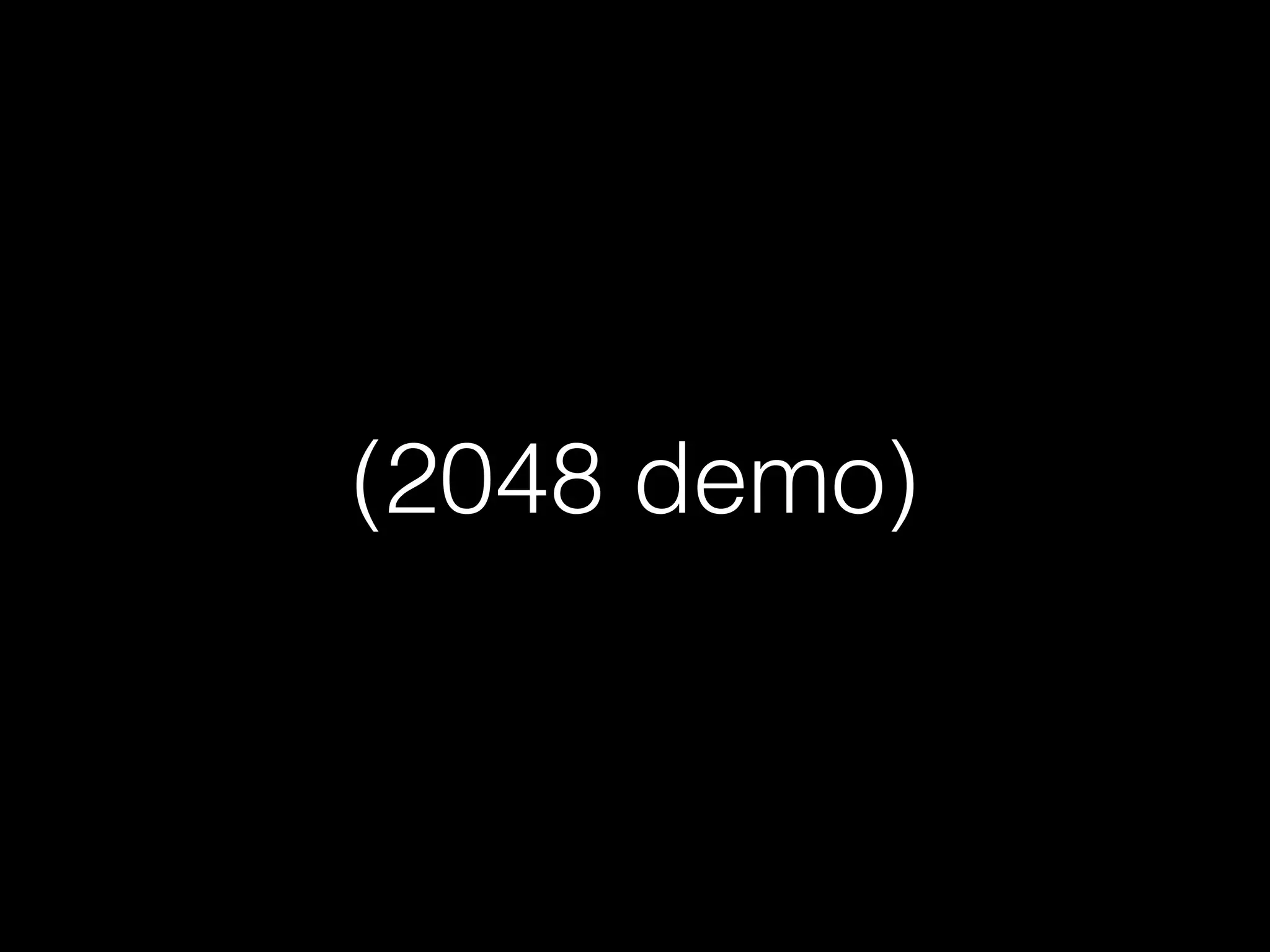
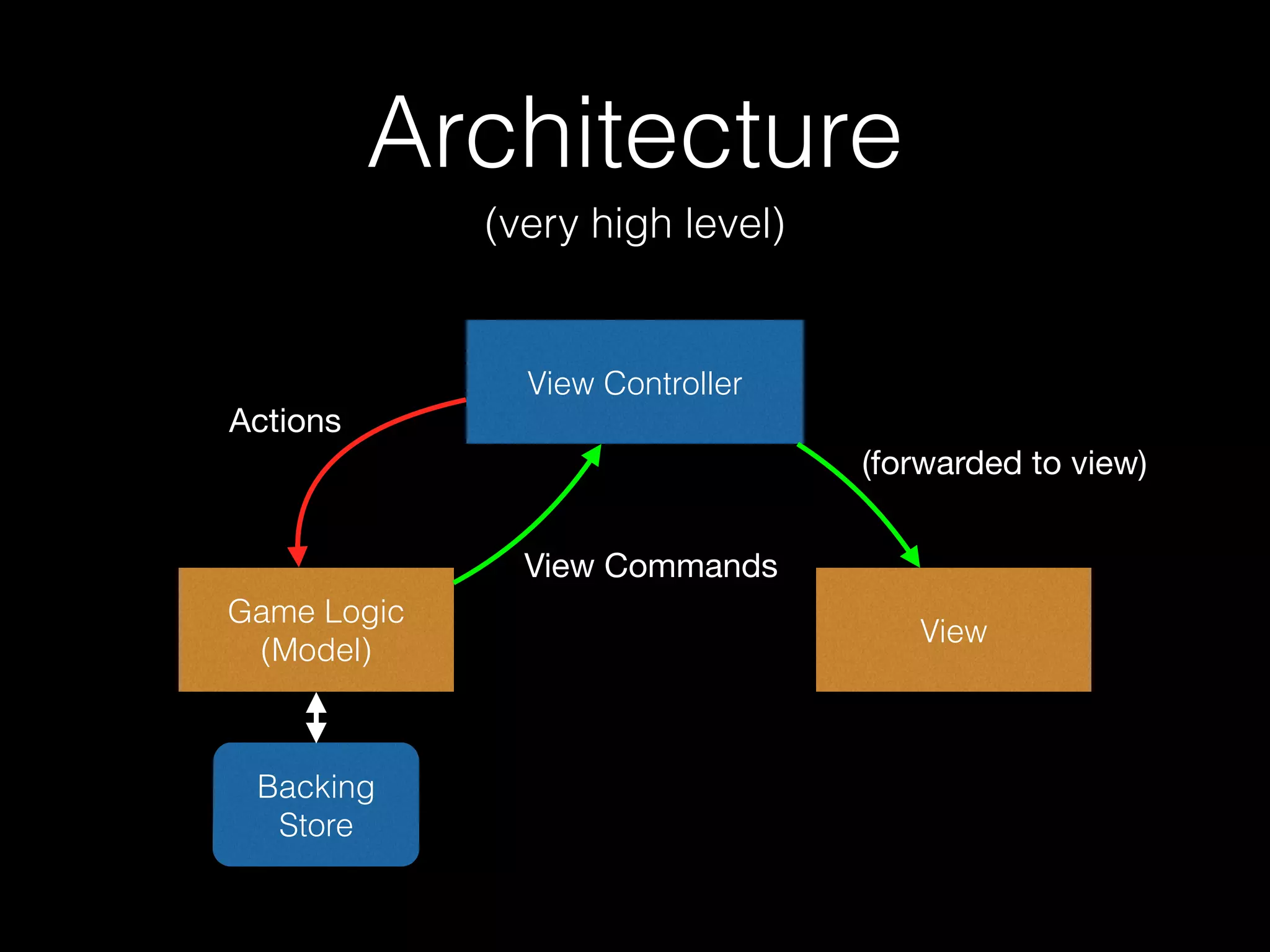
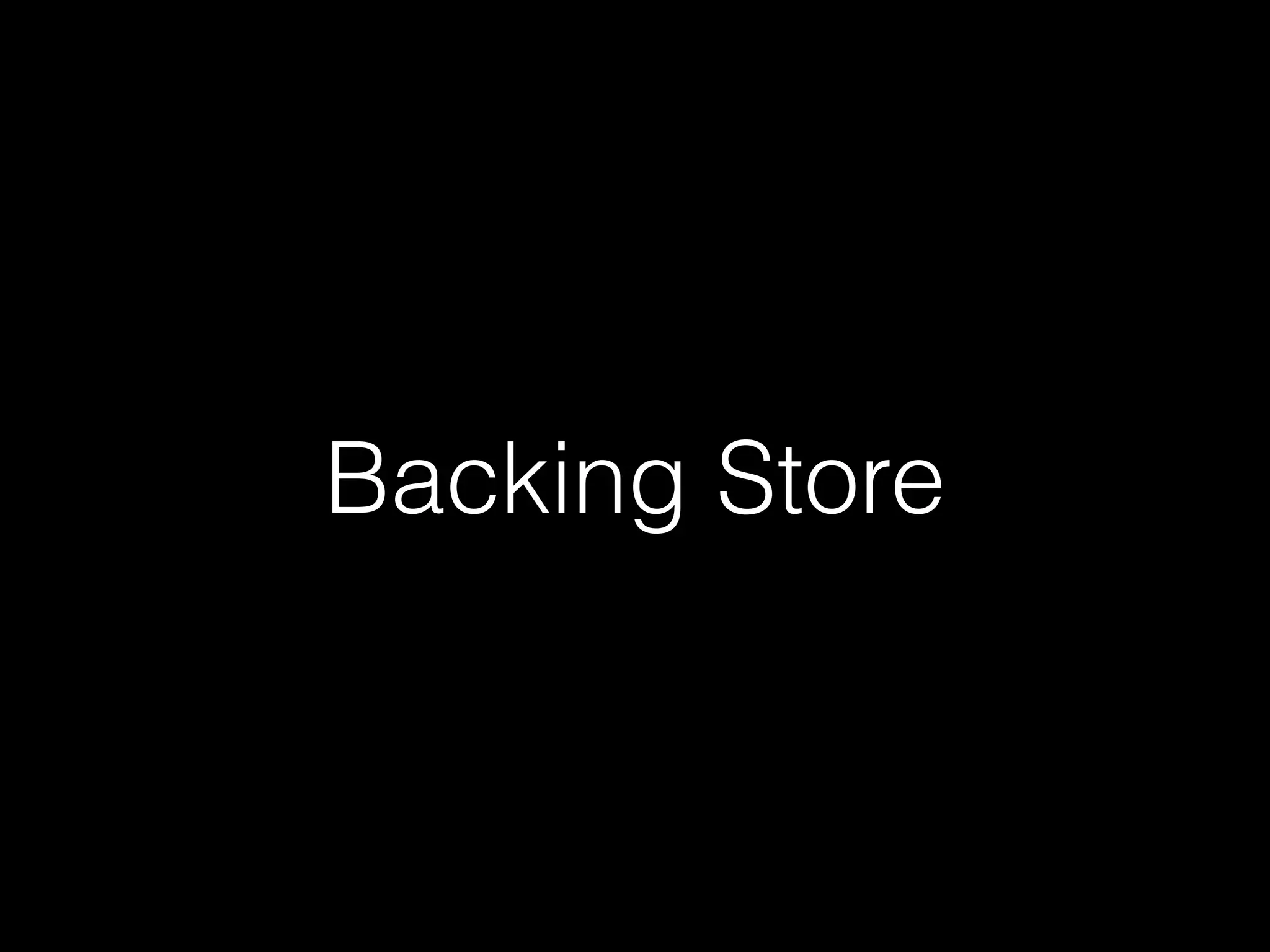
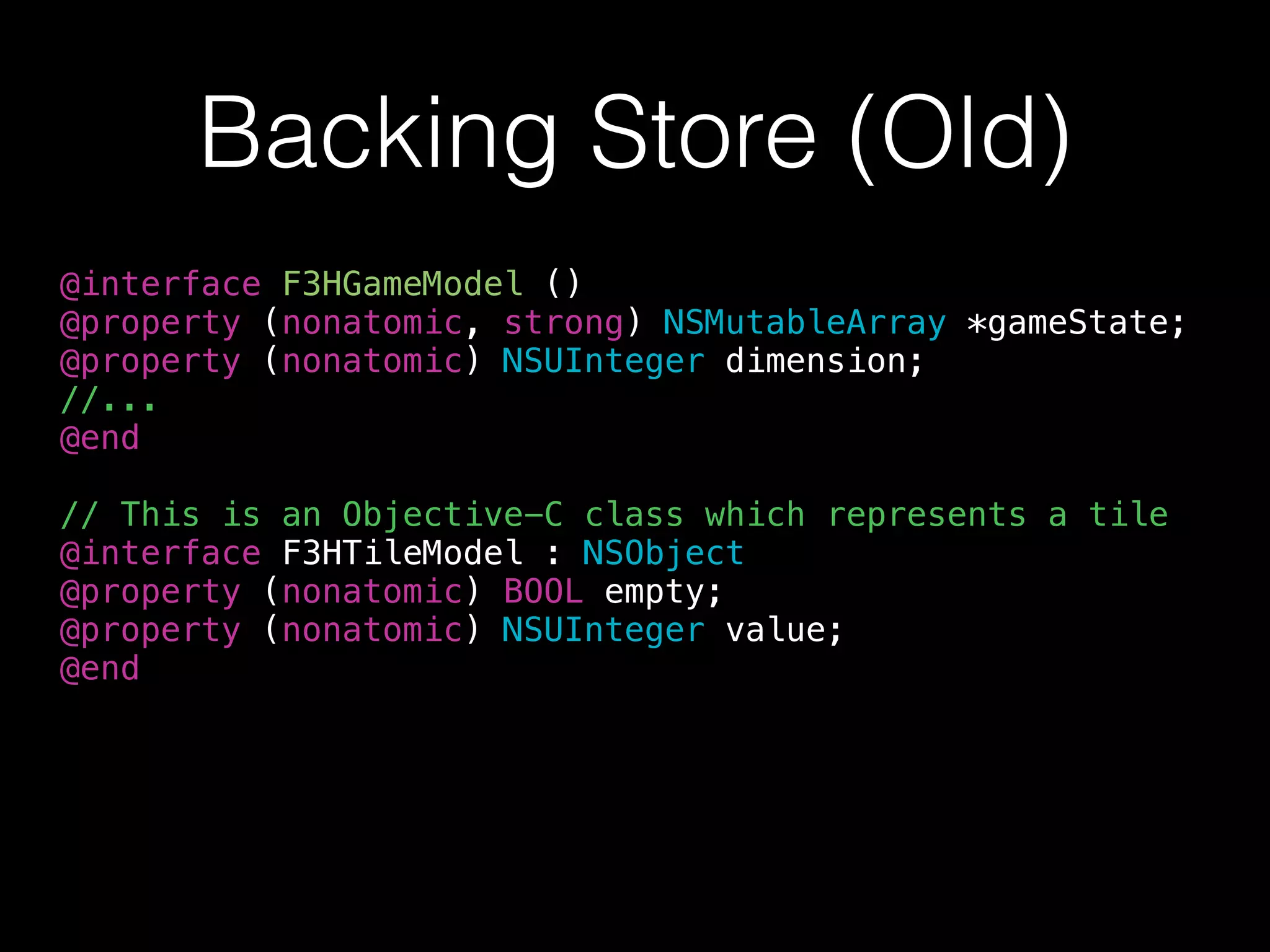
![Backing Store
struct SquareGameboard<T> {
var boardArray: [T]; let dimension: Int
!
init(dimension d: Int, initialValue: T) {
dimension = d
boardArray = [T](count:d*d, repeatedValue:initialValue)
}
!
subscript(row: Int, col: Int) -> T {
get {
return boardArray[row*dimension + col]
}
set {
boardArray[row*dimension + col] = newValue
}
}
}](https://image.slidesharecdn.com/swiftpresentation-1-140723181949-phpapp02/75/Swift-via-swift-2048-8-2048.jpg)
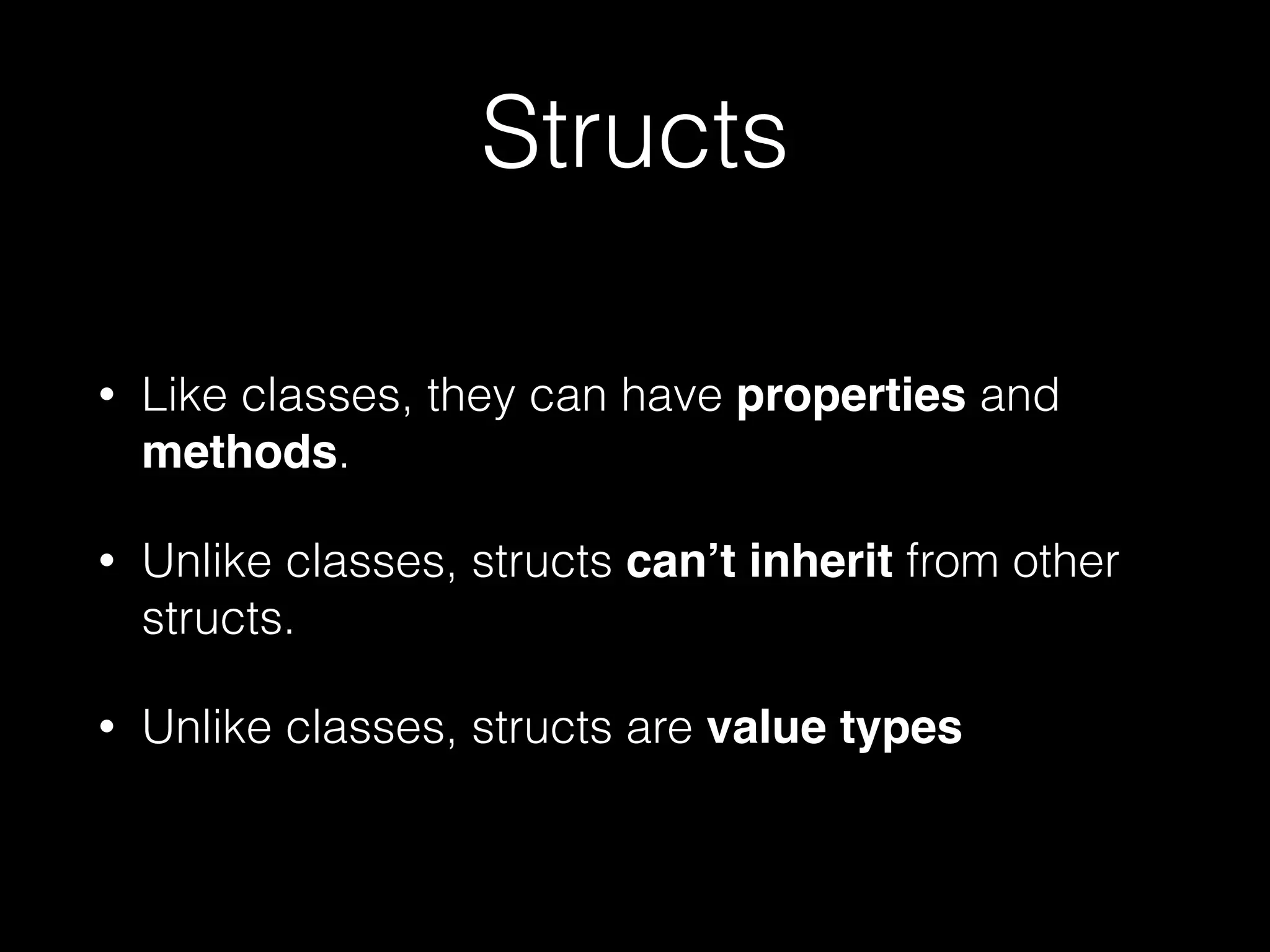
![Generics
struct SquareGameboard<T> {
let dimension: Int
var boardArray: [T]
!
init(dimension d: Int, initialValue: T) {
dimension = d
boardArray = [T](count:d*d, repeatedValue:initialValue)
}
}](https://image.slidesharecdn.com/swiftpresentation-1-140723181949-phpapp02/75/Swift-via-swift-2048-10-2048.jpg)
![Subscripts
subscript(row: Int, col: Int) -> T {
get {
return boardArray[row*dimension + col]
}
set {
boardArray[row*dimension + col] = newValue
}
}
gameboard[x, y] = TileObject.Empty
!
let someTile = gameboard[x, y]](https://image.slidesharecdn.com/swiftpresentation-1-140723181949-phpapp02/75/Swift-via-swift-2048-11-2048.jpg)
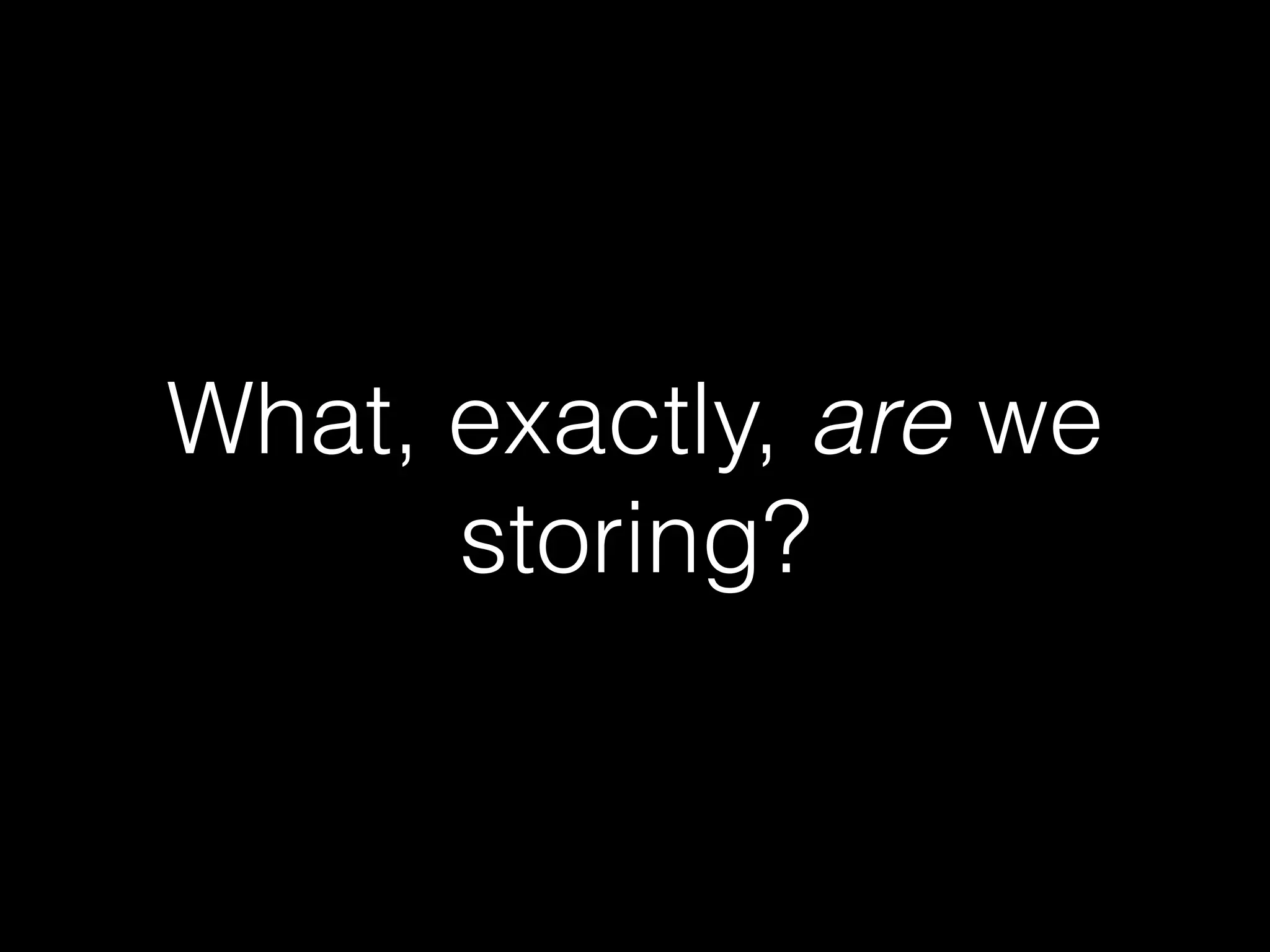
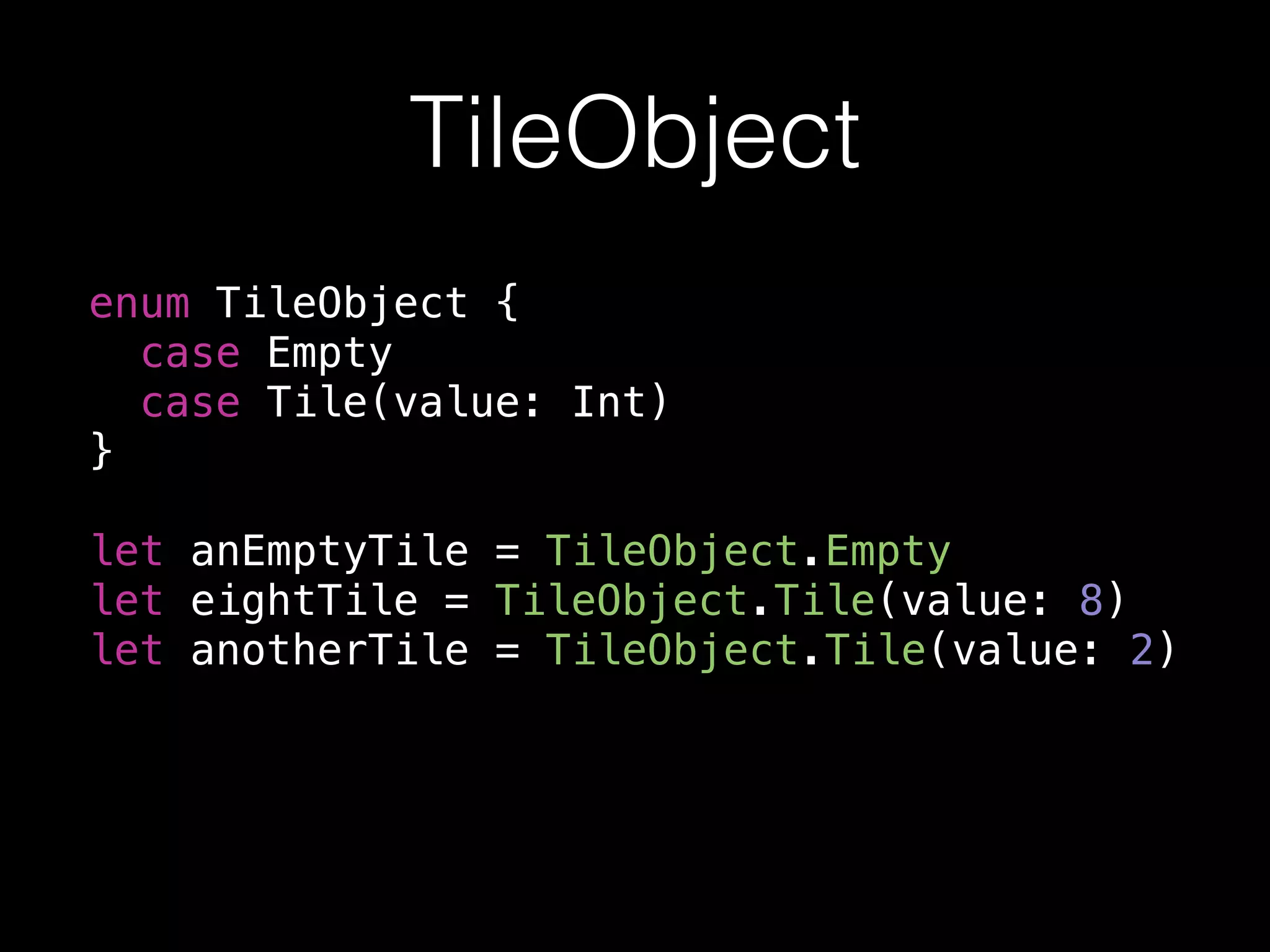
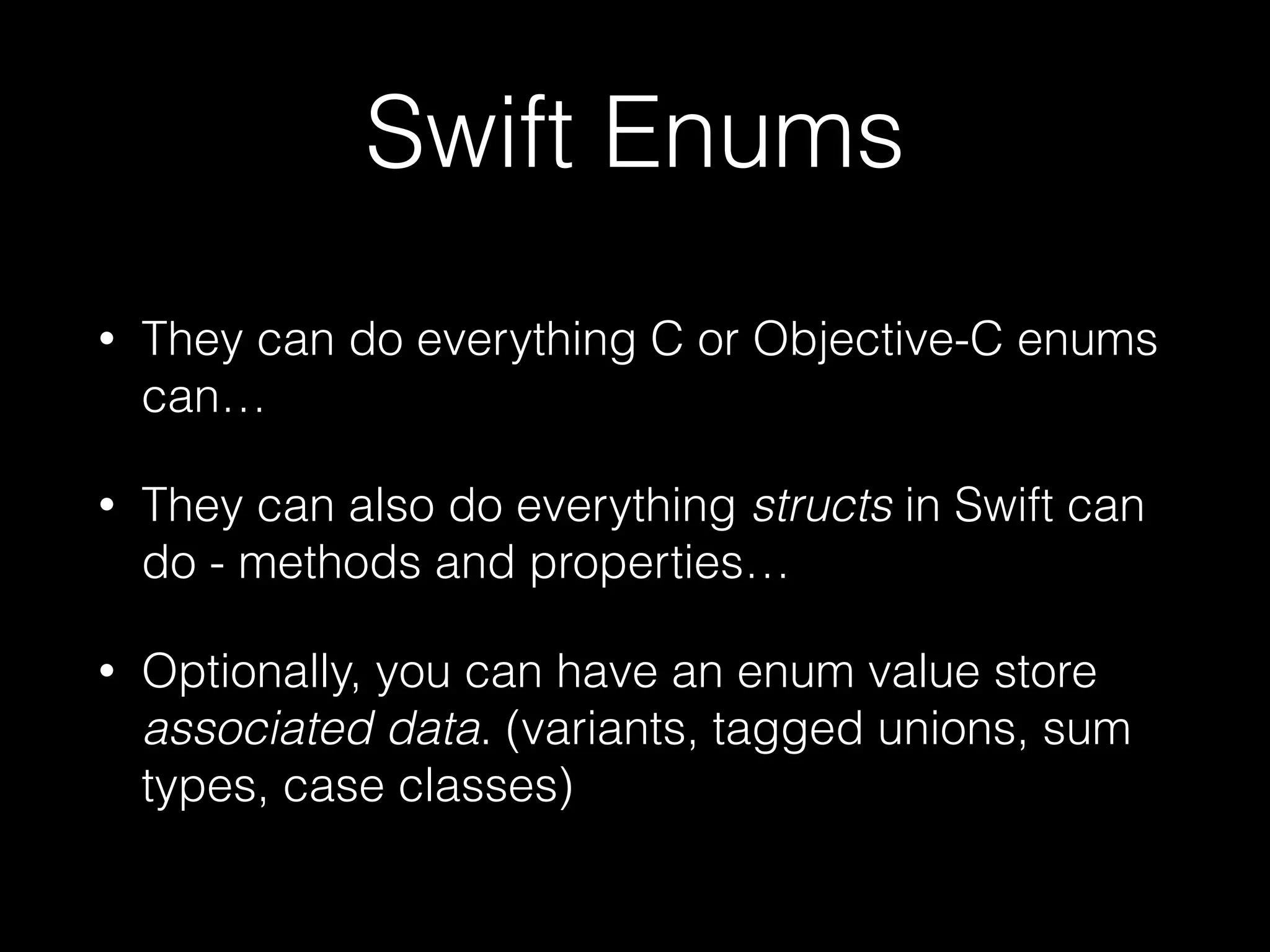
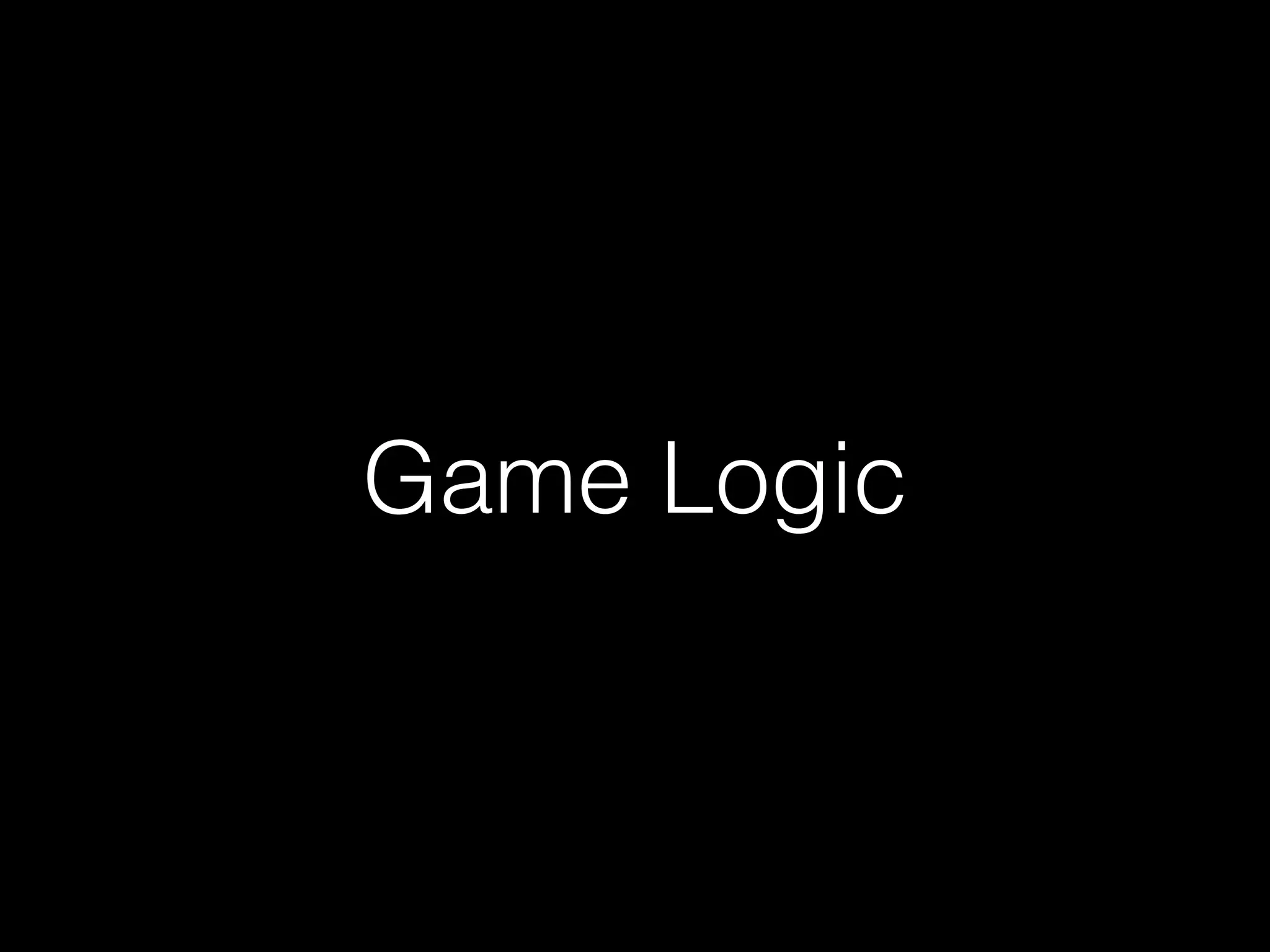
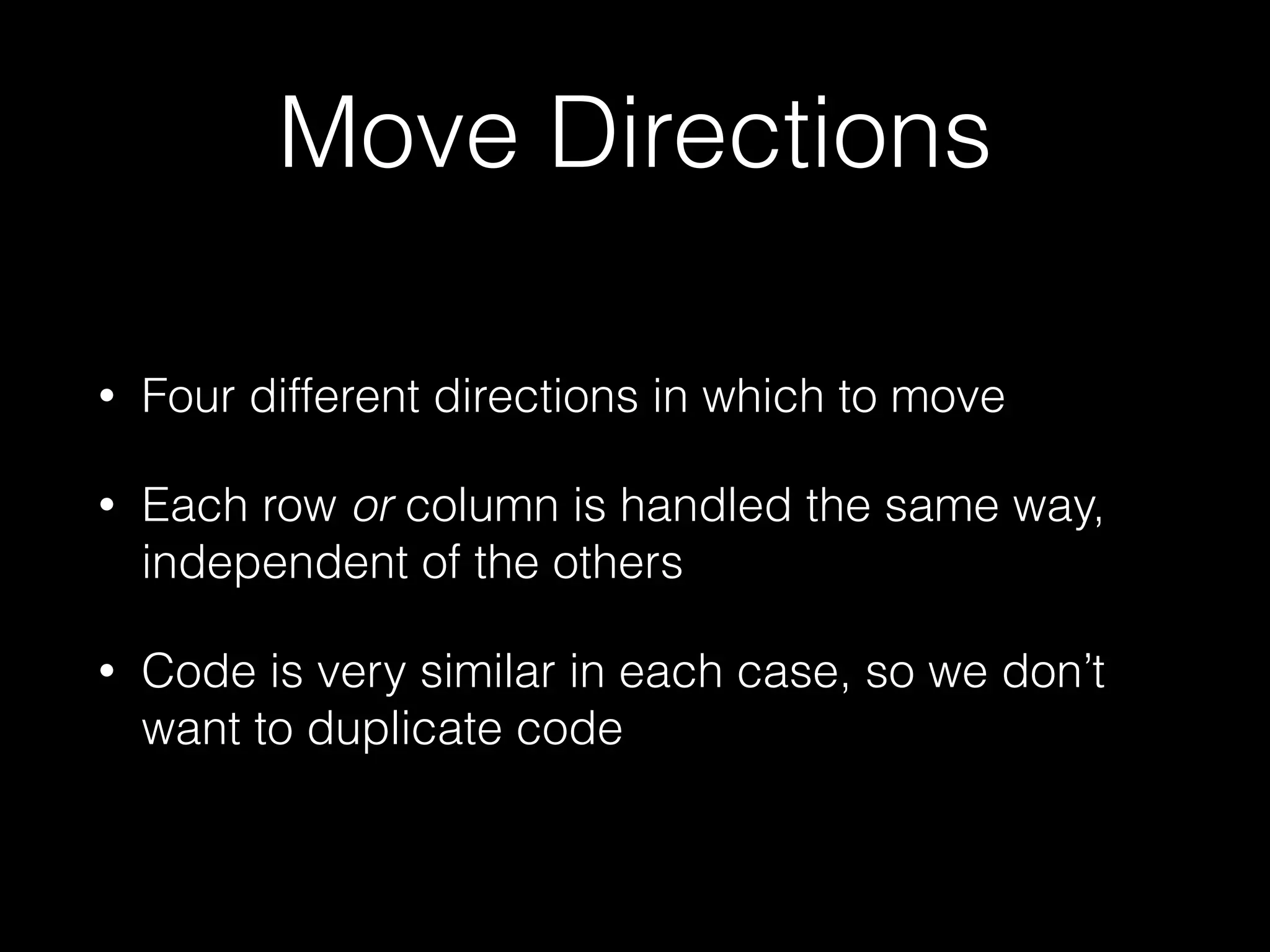
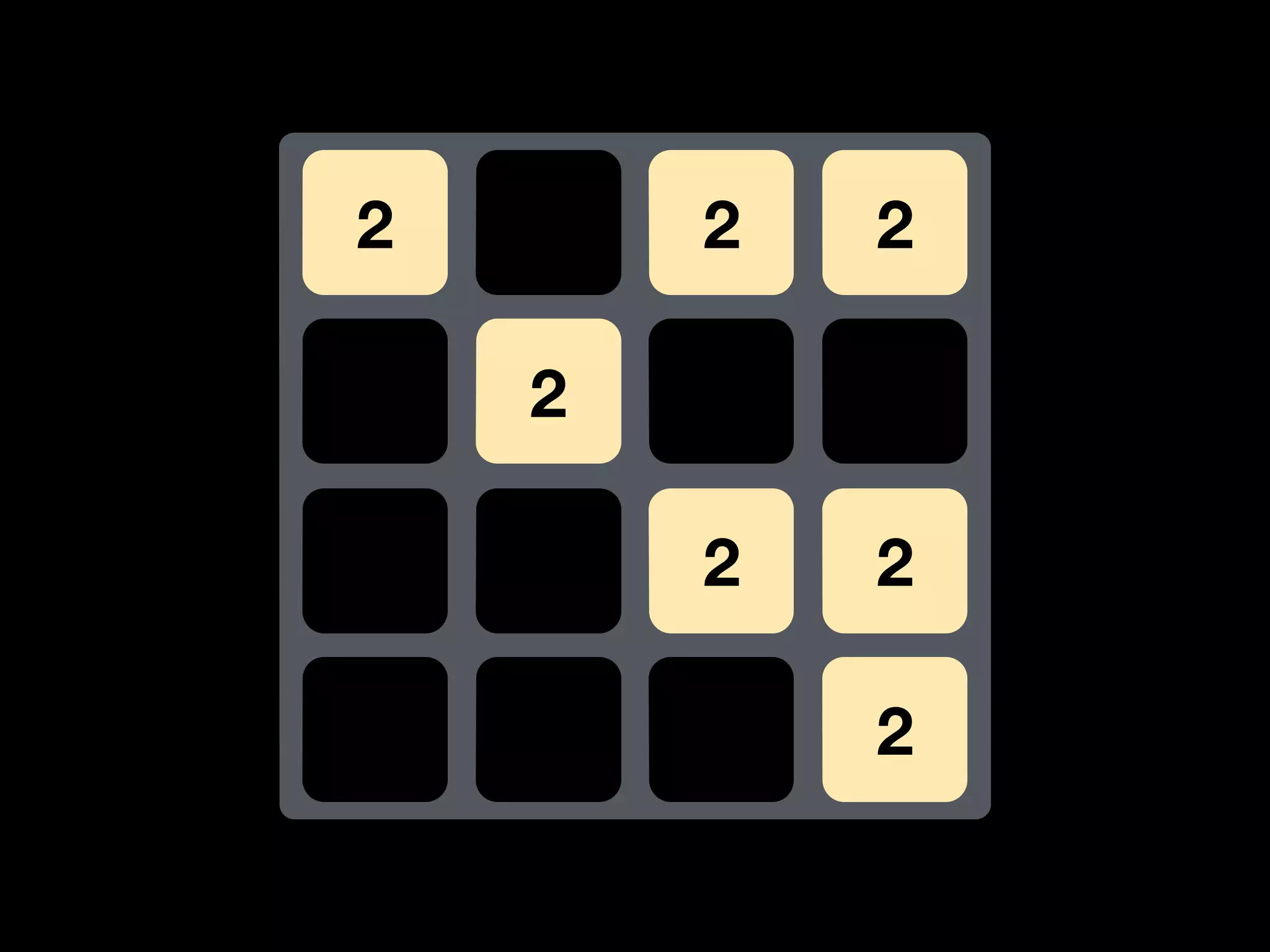
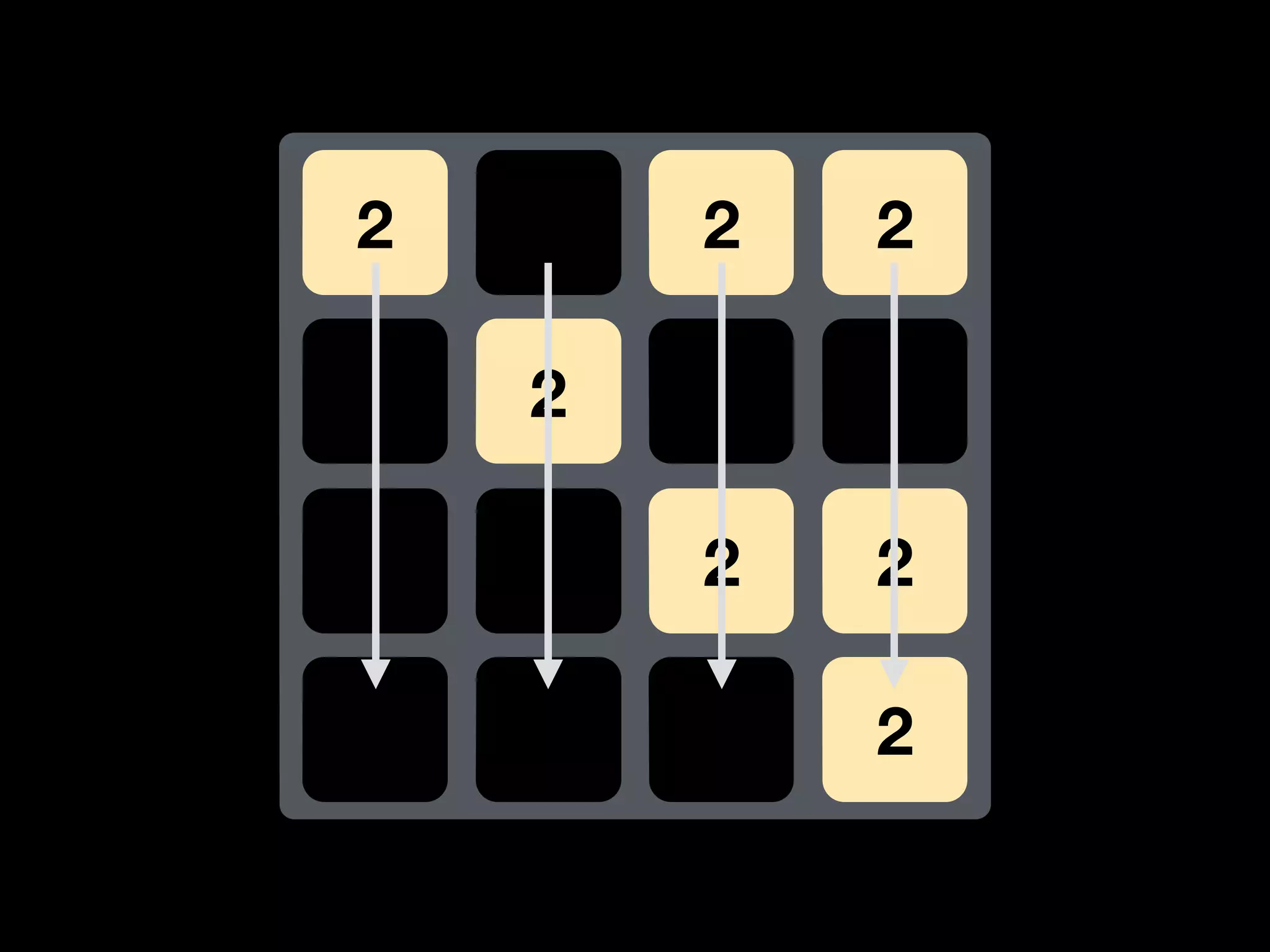
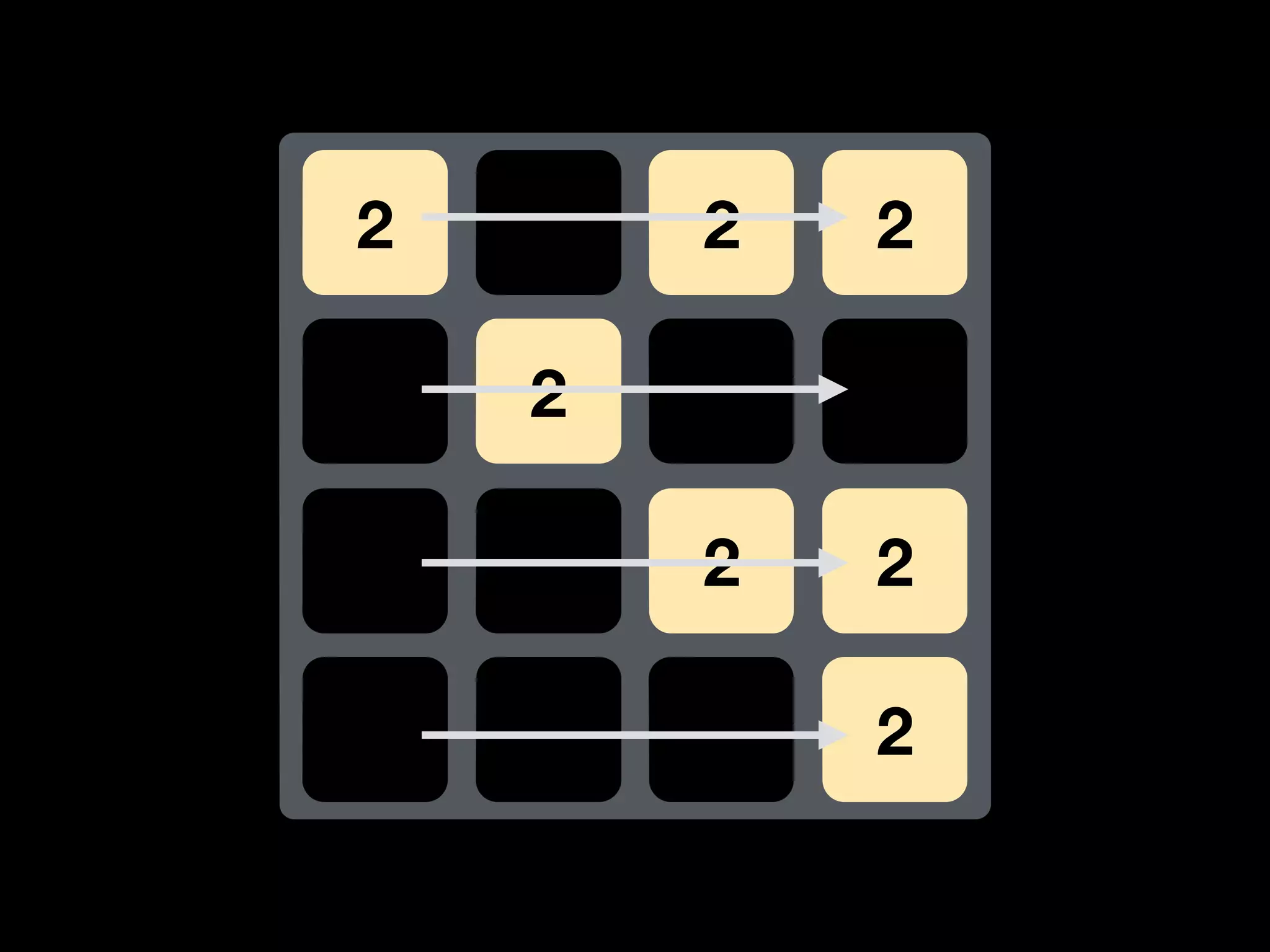
![func performMove(direction: MoveDirection) -> Bool {
func coordinateGenerator(currentRowOrColumn: Int) -> [(Int, Int)] {
var buffer = Array<(Int, Int)>(count:self.dimension, repeatedValue: (0, 0))
for i in 0..<self.dimension {
switch direction {
case .Up: buffer[i] = (i, currentRowOrColumn)
case .Down: buffer[i] = (self.dimension - i - 1, currentRowOrColumn)
case .Left: buffer[i] = (currentRowOrColumn, i)
case .Right: buffer[i] = (currentRowOrColumn, self.dimension - i - 1)
}
}
return buffer
}
!
for i in 0..<dimension {
let coords = coordinateGenerator(i)
let tiles = coords.map() { (c: (Int, Int)) -> TileObject in
let (x, y) = c
return self.gameboard[x, y]
}
let orders = merge(tiles)
// ...
}
// ...
}](https://image.slidesharecdn.com/swiftpresentation-1-140723181949-phpapp02/75/Swift-via-swift-2048-20-2048.jpg)
![func performMove(direction: MoveDirection) -> Bool {
func coordinateGenerator(currentRowOrColumn: Int) -> [(Int, Int)] {
var buffer = Array<(Int, Int)>(count:self.dimension, repeatedValue: (0, 0))
for i in 0..<self.dimension {
switch direction {
case .Up: buffer[i] = (i, currentRowOrColumn)
case .Down: buffer[i] = (self.dimension - i - 1, currentRowOrColumn)
case .Left: buffer[i] = (currentRowOrColumn, i)
case .Right: buffer[i] = (currentRowOrColumn, self.dimension - i - 1)
}
}
return buffer
}
!
for i in 0..<dimension {
let coords = coordinateGenerator(i)
let tiles = coords.map() { (c: (Int, Int)) -> TileObject in
let (x, y) = c
return self.gameboard[x, y]
}
let orders = merge(tiles)
// ...
}
// ...
}](https://image.slidesharecdn.com/swiftpresentation-1-140723181949-phpapp02/75/Swift-via-swift-2048-21-2048.jpg)
![func performMove(direction: MoveDirection) -> Bool {
func coordinateGenerator(currentRowOrColumn: Int) -> [(Int, Int)] {
var buffer = Array<(Int, Int)>(count:self.dimension, repeatedValue: (0, 0))
for i in 0..<self.dimension {
switch direction {
case .Up: buffer[i] = (i, currentRowOrColumn)
case .Down: buffer[i] = (self.dimension - i - 1, currentRowOrColumn)
case .Left: buffer[i] = (currentRowOrColumn, i)
case .Right: buffer[i] = (currentRowOrColumn, self.dimension - i - 1)
}
}
return buffer
}
!
for i in 0..<dimension {
let coords = coordinateGenerator(i)
let tiles = coords.map() { (c: (Int, Int)) -> TileObject in
let (x, y) = c
return self.gameboard[x, y]
}
let orders = merge(tiles)
// ...
}
// ...
}](https://image.slidesharecdn.com/swiftpresentation-1-140723181949-phpapp02/75/Swift-via-swift-2048-22-2048.jpg)
![func performMove(direction: MoveDirection) -> Bool {
func coordinateGenerator(currentRowOrColumn: Int) -> [(Int, Int)] {
var buffer = Array<(Int, Int)>(count:self.dimension, repeatedValue: (0, 0))
for i in 0..<self.dimension {
switch direction {
case .Up: buffer[i] = (i, currentRowOrColumn)
case .Down: buffer[i] = (self.dimension - i - 1, currentRowOrColumn)
case .Left: buffer[i] = (currentRowOrColumn, i)
case .Right: buffer[i] = (currentRowOrColumn, self.dimension - i - 1)
}
}
return buffer
}
!
for i in 0..<dimension {
let coords = coordinateGenerator(i)
let tiles = coords.map() { (c: (Int, Int)) -> TileObject in
let (x, y) = c
return self.gameboard[x, y]
}
let orders = merge(tiles)
// ...
}
// ...
}](https://image.slidesharecdn.com/swiftpresentation-1-140723181949-phpapp02/75/Swift-via-swift-2048-23-2048.jpg)
![func performMove(direction: MoveDirection) -> Bool {
func coordinateGenerator(currentRowOrColumn: Int) -> [(Int, Int)] {
var buffer = Array<(Int, Int)>(count:self.dimension, repeatedValue: (0, 0))
for i in 0..<self.dimension {
switch direction {
case .Up: buffer[i] = (i, currentRowOrColumn)
case .Down: buffer[i] = (self.dimension - i - 1, currentRowOrColumn)
case .Left: buffer[i] = (currentRowOrColumn, i)
case .Right: buffer[i] = (currentRowOrColumn, self.dimension - i - 1)
}
}
return buffer
}
!
for i in 0..<dimension {
let coords = coordinateGenerator(i)
let tiles = coords.map() { (c: (Int, Int)) -> TileObject in
let (x, y) = c
return self.gameboard[x, y]
}
let orders = merge(tiles)
// ...
}
// ...
}](https://image.slidesharecdn.com/swiftpresentation-1-140723181949-phpapp02/75/Swift-via-swift-2048-24-2048.jpg)
![func performMove(direction: MoveDirection) -> Bool {
func coordinateGenerator(currentRowOrColumn: Int) -> [(Int, Int)] {
var buffer = Array<(Int, Int)>(count:self.dimension, repeatedValue: (0, 0))
for i in 0..<self.dimension {
switch direction {
case .Up: buffer[i] = (i, currentRowOrColumn)
case .Down: buffer[i] = (self.dimension - i - 1, currentRowOrColumn)
case .Left: buffer[i] = (currentRowOrColumn, i)
case .Right: buffer[i] = (currentRowOrColumn, self.dimension - i - 1)
}
}
return buffer
}
!
for i in 0..<dimension {
let coords = coordinateGenerator(i)
let tiles = coords.map() { (c: (Int, Int)) -> TileObject in
let (x, y) = c
return self.gameboard[x, y]
}
let orders = merge(tiles)
// ...
}
// ...
}](https://image.slidesharecdn.com/swiftpresentation-1-140723181949-phpapp02/75/Swift-via-swift-2048-25-2048.jpg)
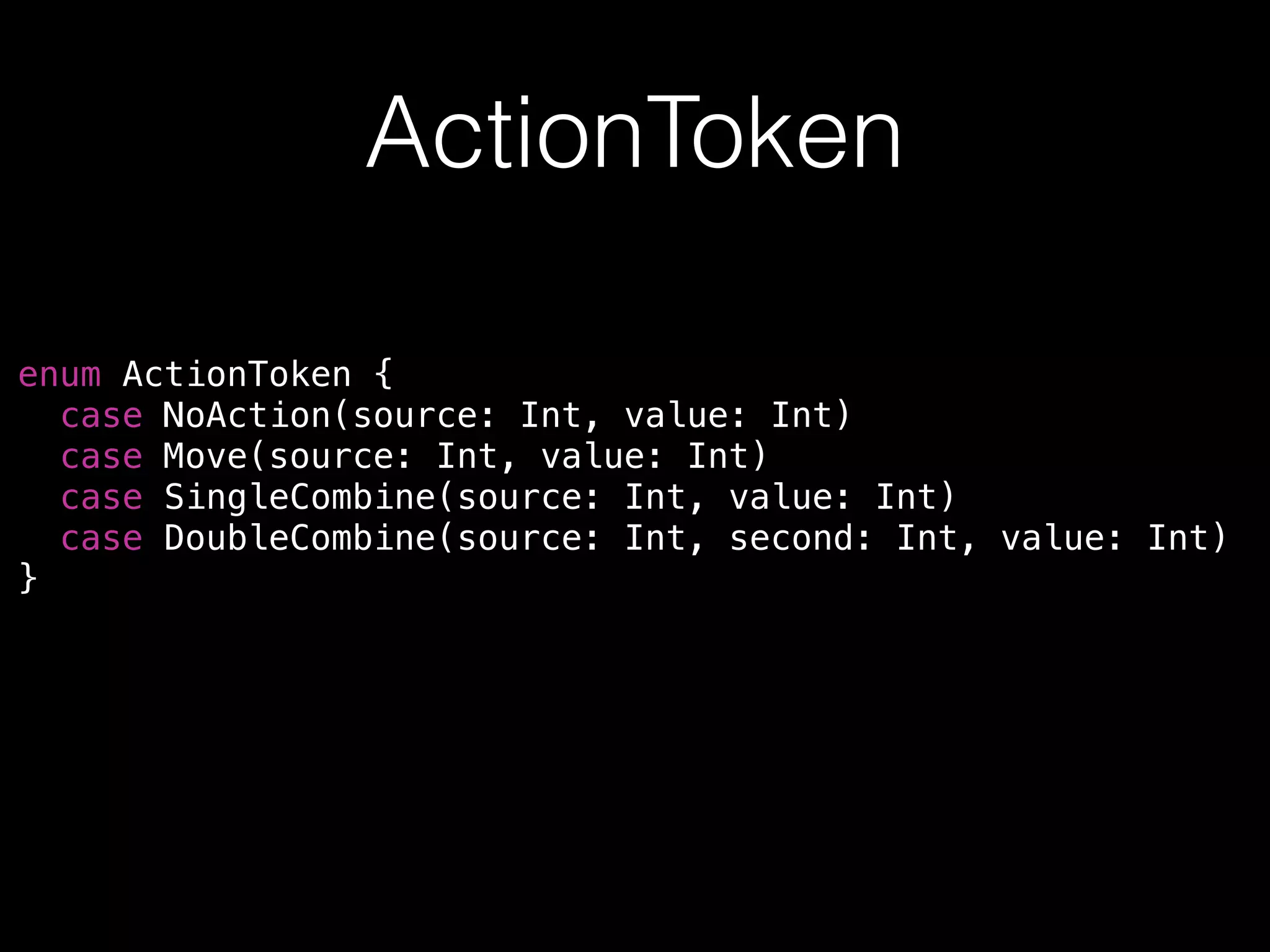
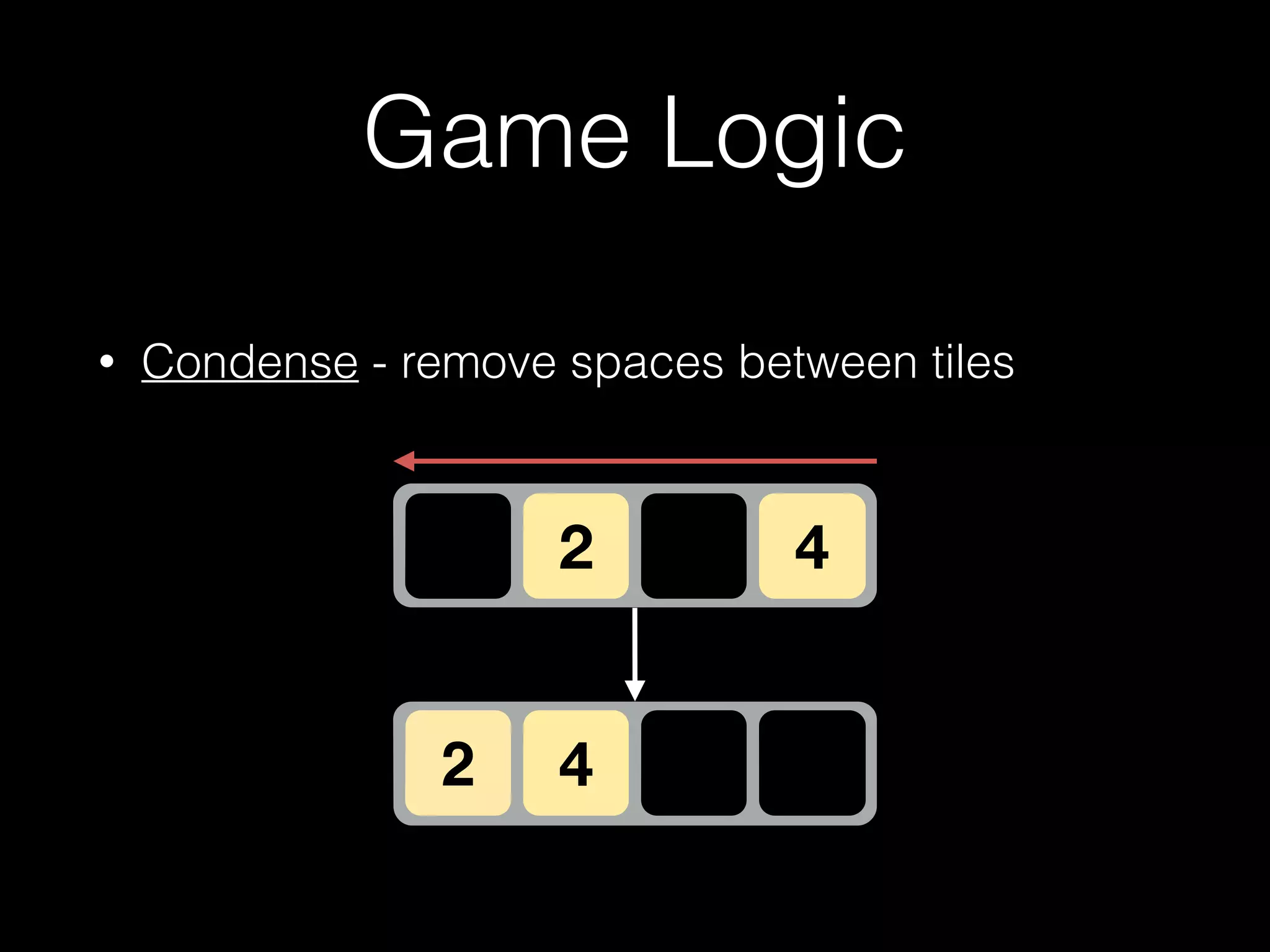
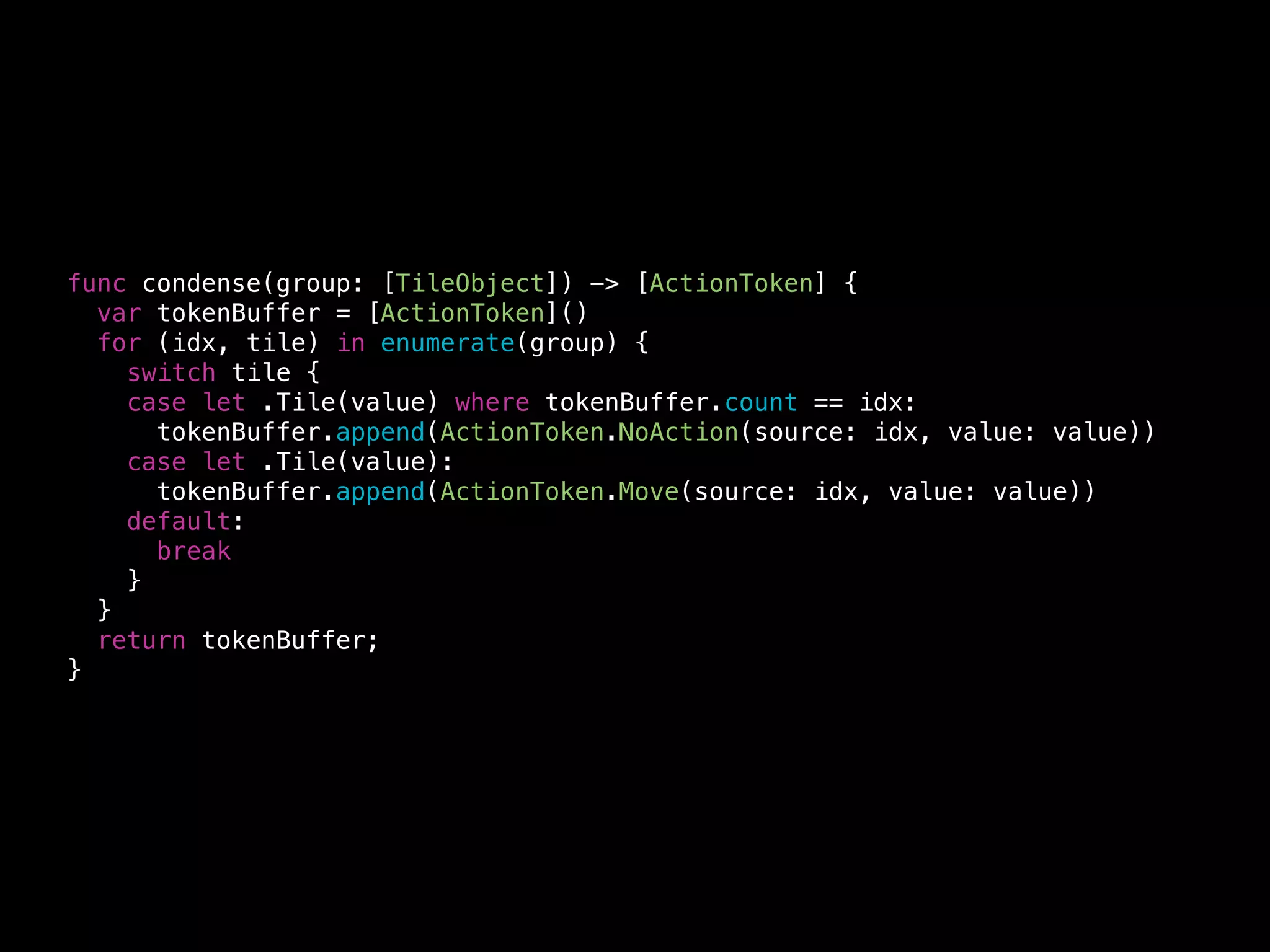
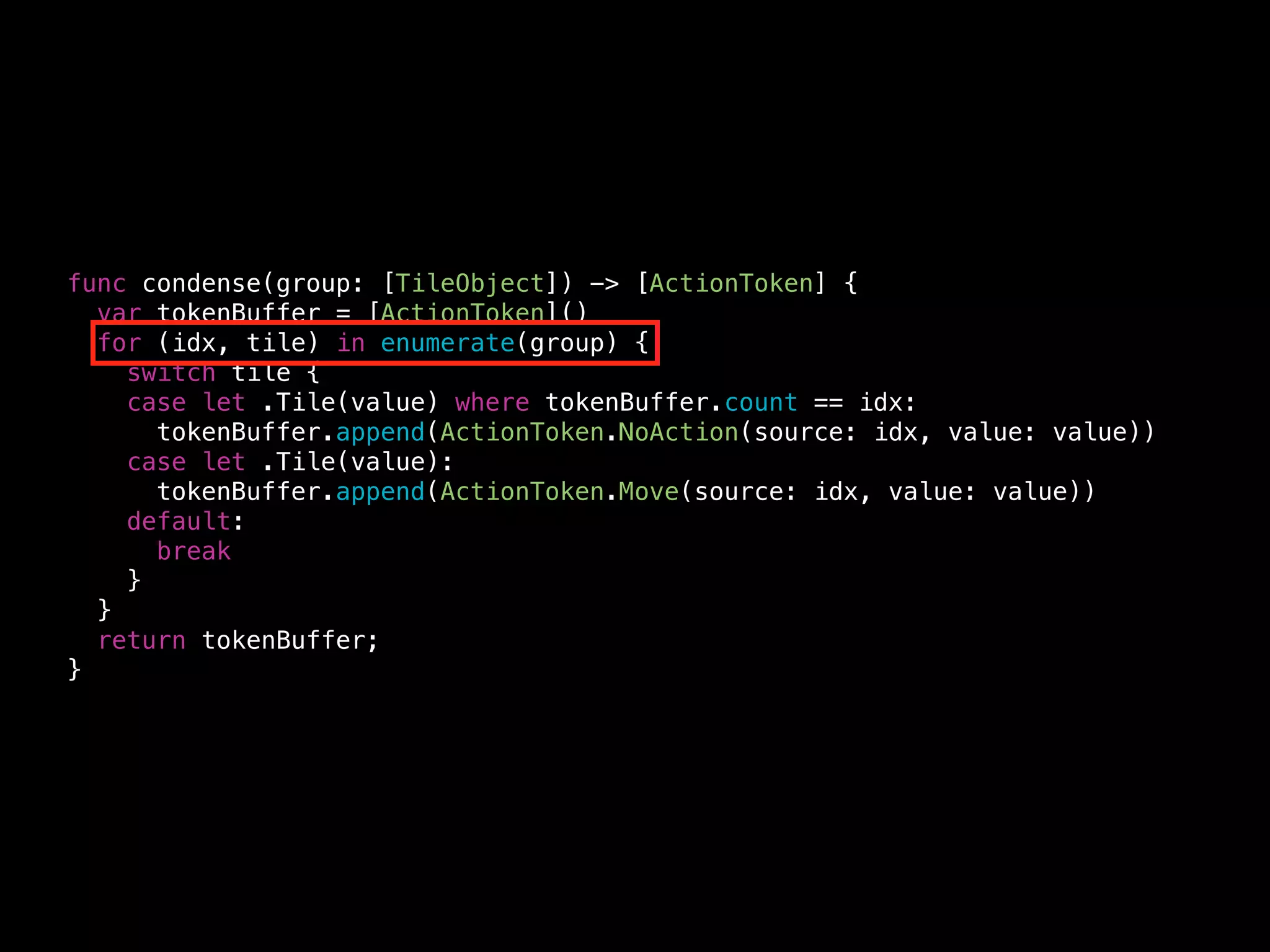
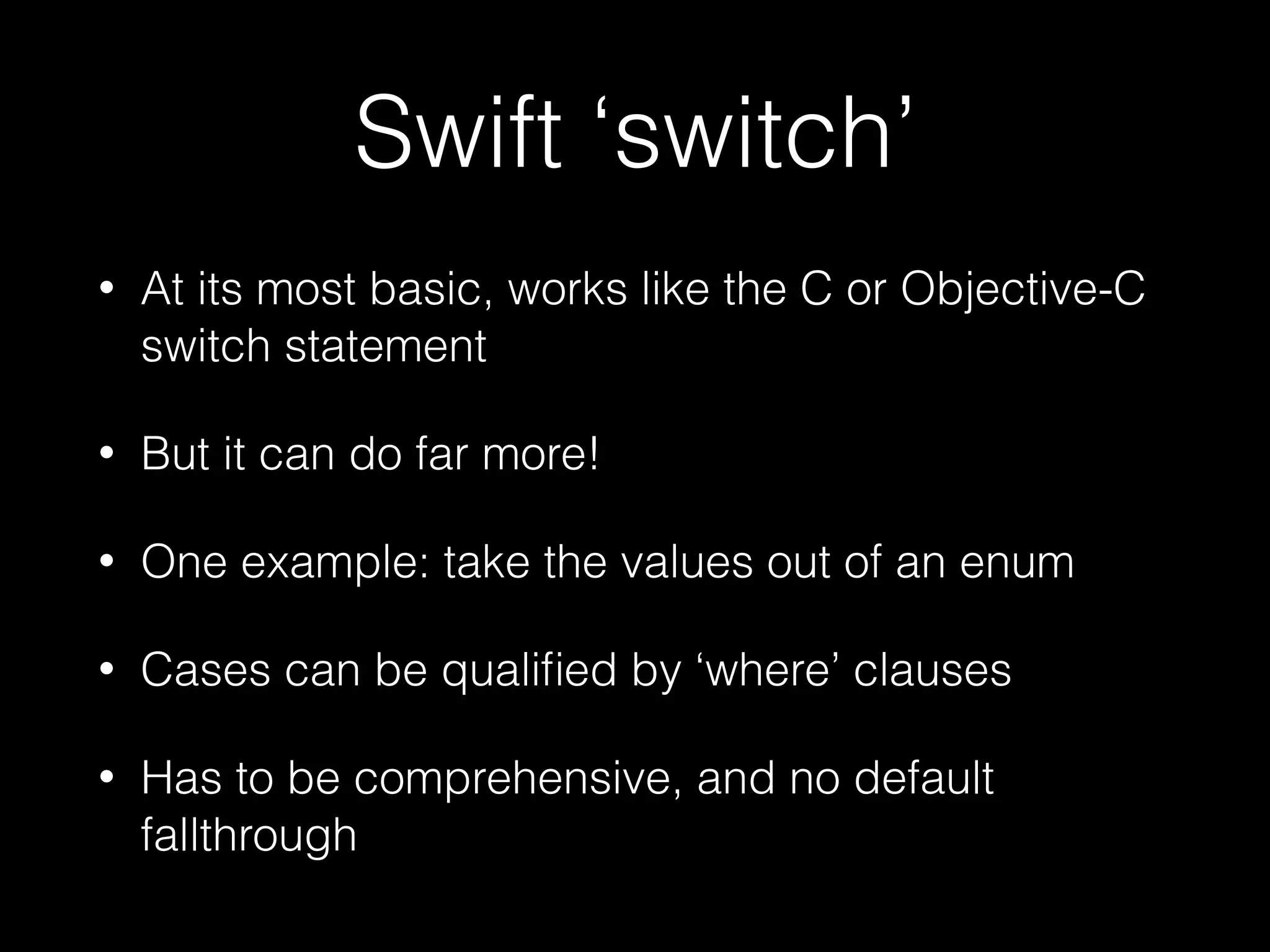
![func condense(group: [TileObject]) -> [ActionToken] {
var tokenBuffer = [ActionToken]()
for (idx, tile) in enumerate(group) {
switch tile {
case let .Tile(value) where tokenBuffer.count == idx:
tokenBuffer.append(ActionToken.NoAction(source: idx, value: value))
case let .Tile(value):
tokenBuffer.append(ActionToken.Move(source: idx, value: value))
default:
break
}
}
return tokenBuffer;
}](https://image.slidesharecdn.com/swiftpresentation-1-140723181949-phpapp02/75/Swift-via-swift-2048-31-2048.jpg)
![func condense(group: [TileObject]) -> [ActionToken] {
var tokenBuffer = [ActionToken]()
for (idx, tile) in enumerate(group) {
switch tile {
case let .Tile(value) where tokenBuffer.count == idx:
tokenBuffer.append(ActionToken.NoAction(source: idx, value: value))
case let .Tile(value):
tokenBuffer.append(ActionToken.Move(source: idx, value: value))
default:
break
}
}
return tokenBuffer;
}](https://image.slidesharecdn.com/swiftpresentation-1-140723181949-phpapp02/75/Swift-via-swift-2048-32-2048.jpg)
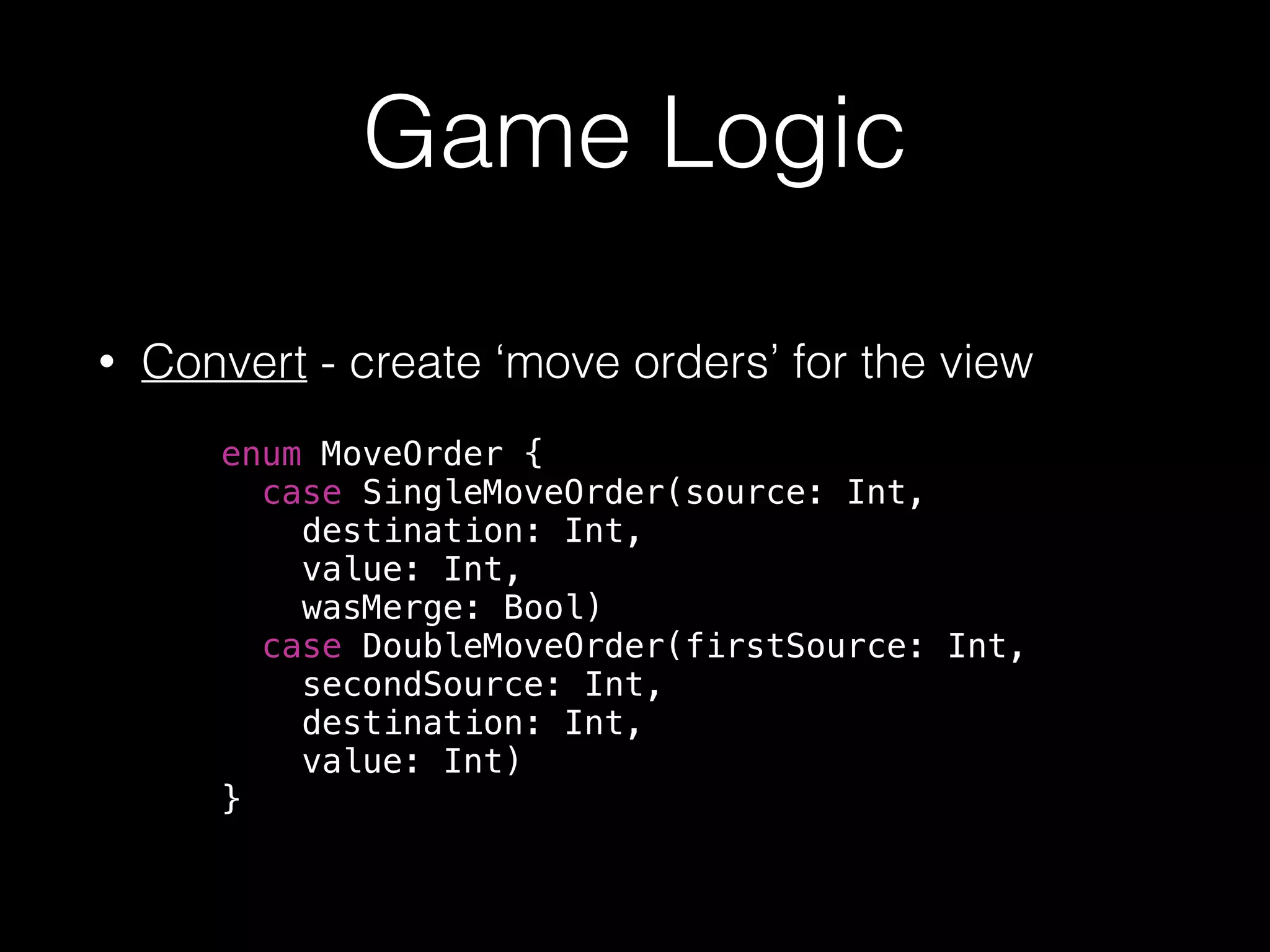
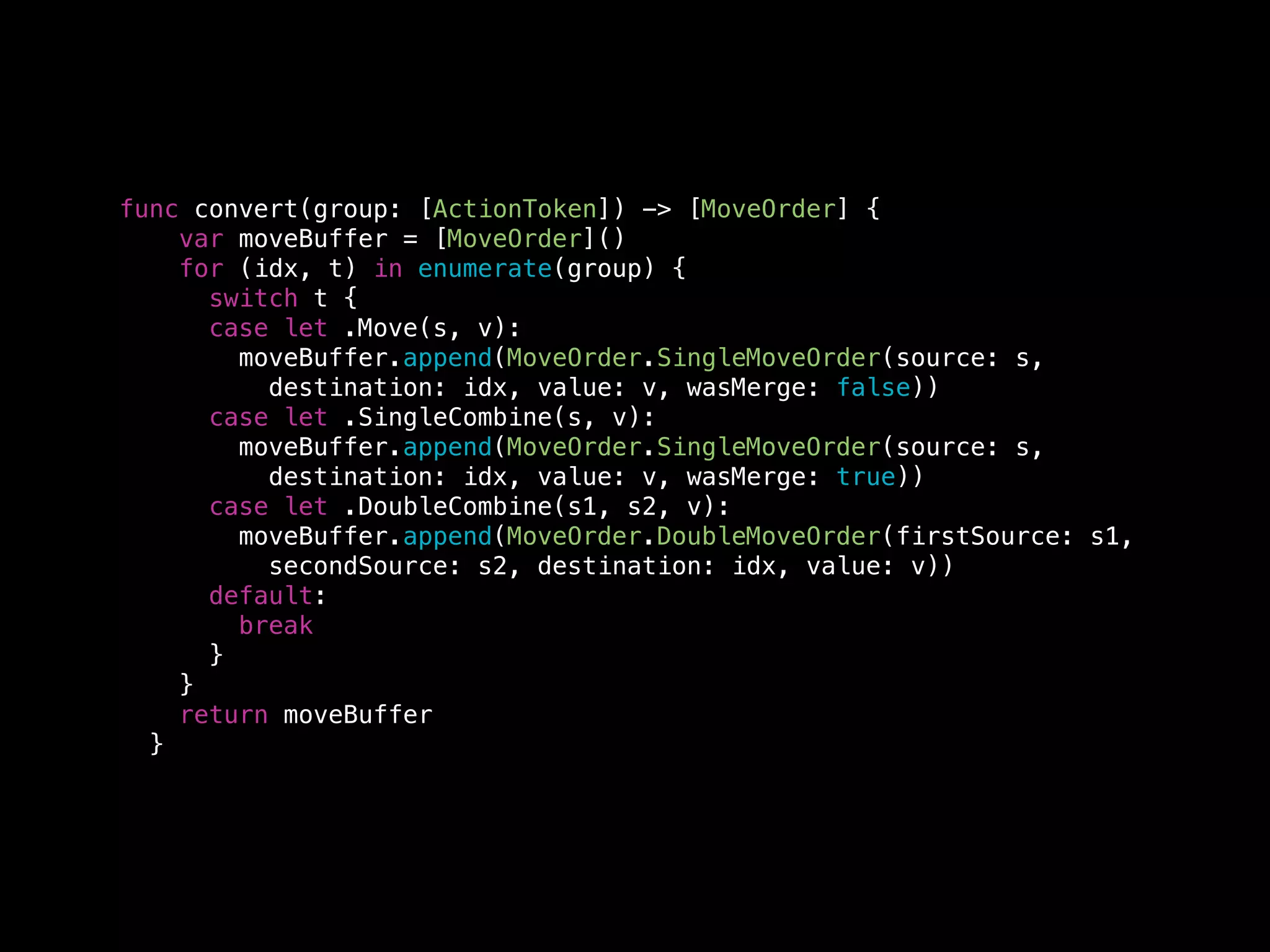
![func collapse(group: [ActionToken]) -> [ActionToken] {
func quiescentTileStillQuiescent(inputPosition: Int, outputLength: Int, originalPosition: Int) -> Bool {
return (inputPosition == outputLength) && (originalPosition == inputPosition)
}
!
var tokenBuffer = [ActionToken]()
var skipNext = false
for (idx, token) in enumerate(group) {
if skipNext {
skipNext = false
continue
}
switch token {
case .SingleCombine:
assert(false, "Cannot have single combine token in input")
case .DoubleCombine:
assert(false, "Cannot have double combine token in input")
case let .NoAction(s, v)
where (idx < group.count-1
&& v == group[idx+1].getValue()
&& quiescentTileStillQuiescent(idx, tokenBuffer.count, s)):
let nv = v + group[idx+1].getValue()
skipNext = true
tokenBuffer.append(ActionToken.SingleCombine(source: next.getSource(), value: nv))
case let t where (idx < group.count-1 && t.getValue() == group[idx+1].getValue()):
let next = group[idx+1]
let nv = t.getValue() + group[idx+1].getValue()
skipNext = true
tokenBuffer.append(ActionToken.DoubleCombine(source: t.getSource(), second: next.getSource(), value: nv))
case let .NoAction(s, v) where !quiescentTileStillQuiescent(idx, tokenBuffer.count, s):
tokenBuffer.append(ActionToken.Move(source: s, value: v))
case let .NoAction(s, v):
tokenBuffer.append(ActionToken.NoAction(source: s, value: v))
case let .Move(s, v):
tokenBuffer.append(ActionToken.Move(source: s, value: v))
default:
break
}
}
return tokenBuffer
}](https://image.slidesharecdn.com/swiftpresentation-1-140723181949-phpapp02/75/Swift-via-swift-2048-35-2048.jpg)
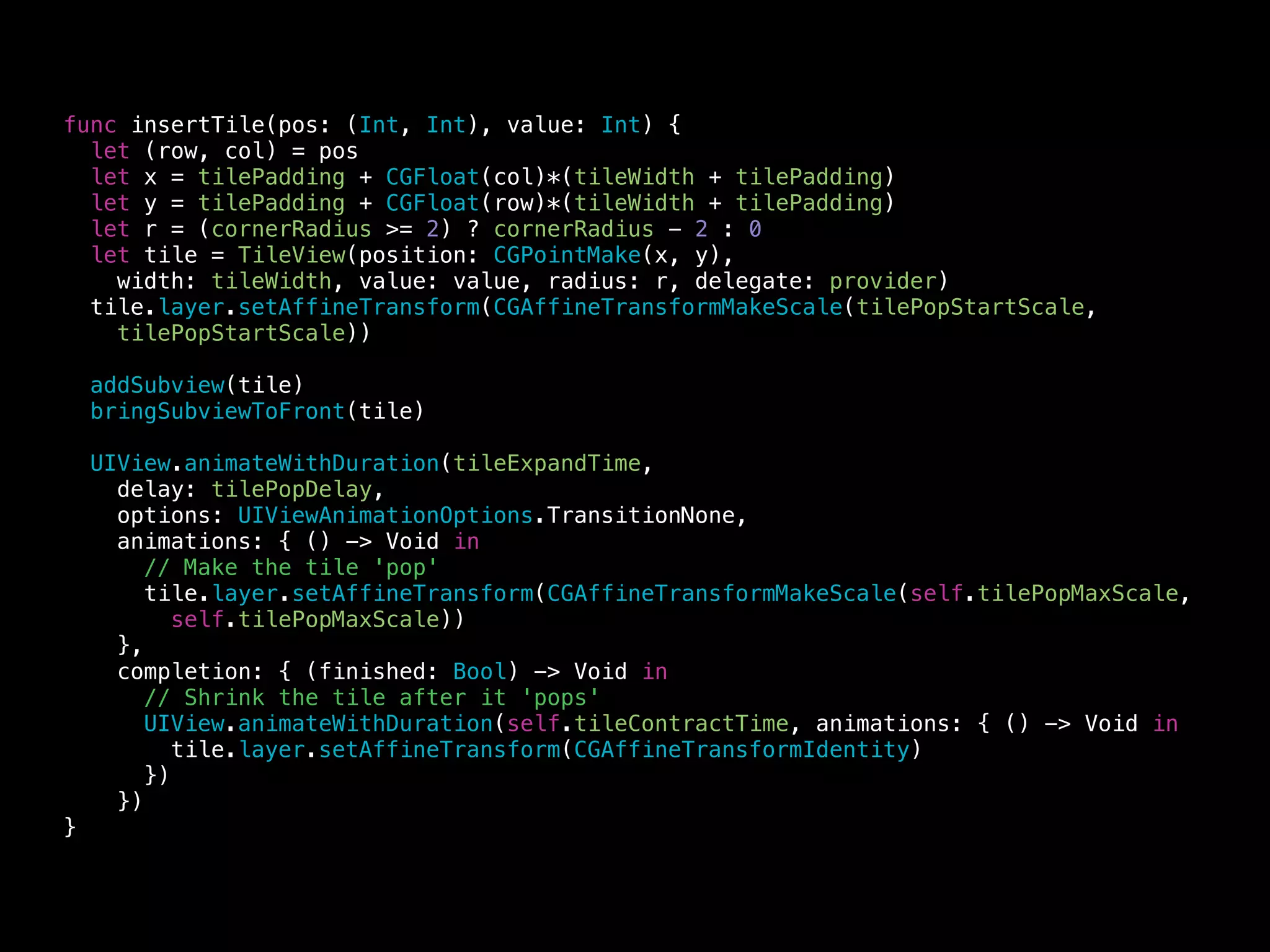
![func convert(group: [ActionToken]) -> [MoveOrder] {
var moveBuffer = [MoveOrder]()
for (idx, t) in enumerate(group) {
switch t {
case let .Move(s, v):
moveBuffer.append(MoveOrder.SingleMoveOrder(source: s,
destination: idx, value: v, wasMerge: false))
case let .SingleCombine(s, v):
moveBuffer.append(MoveOrder.SingleMoveOrder(source: s,
destination: idx, value: v, wasMerge: true))
case let .DoubleCombine(s1, s2, v):
moveBuffer.append(MoveOrder.DoubleMoveOrder(firstSource: s1,
secondSource: s2, destination: idx, value: v))
default:
break
}
}
return moveBuffer
}](https://image.slidesharecdn.com/swiftpresentation-1-140723181949-phpapp02/75/Swift-via-swift-2048-37-2048.jpg)
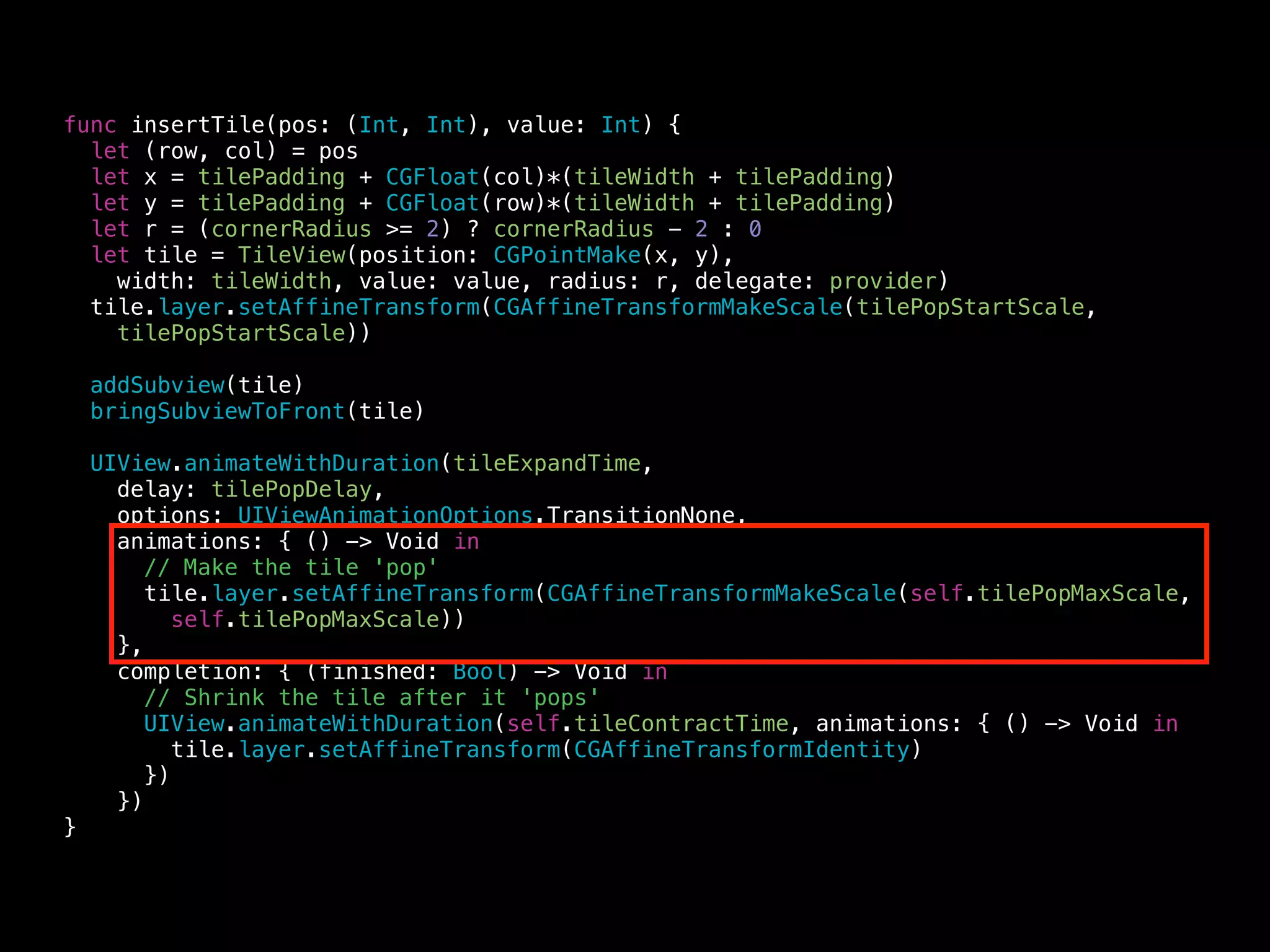
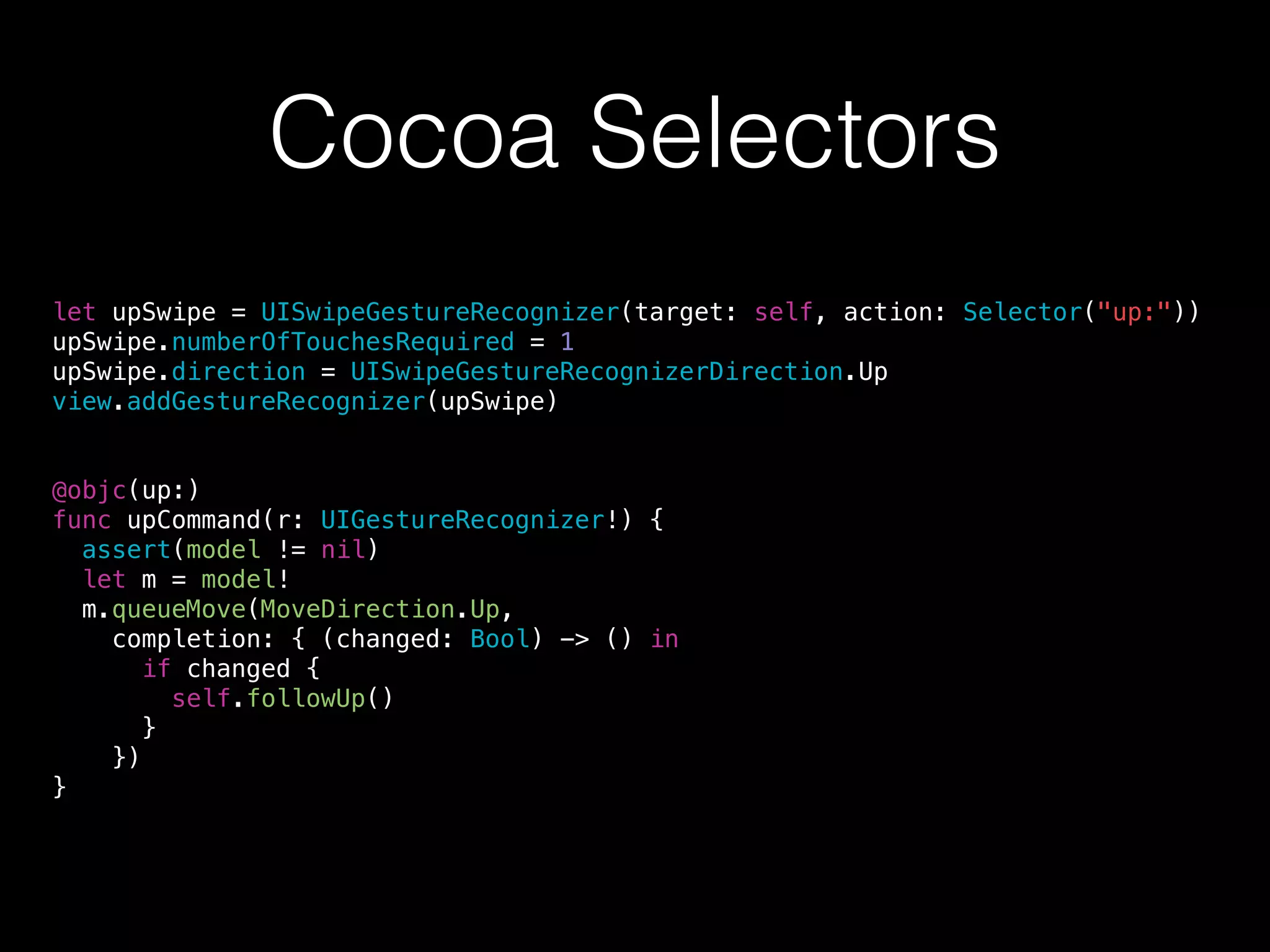
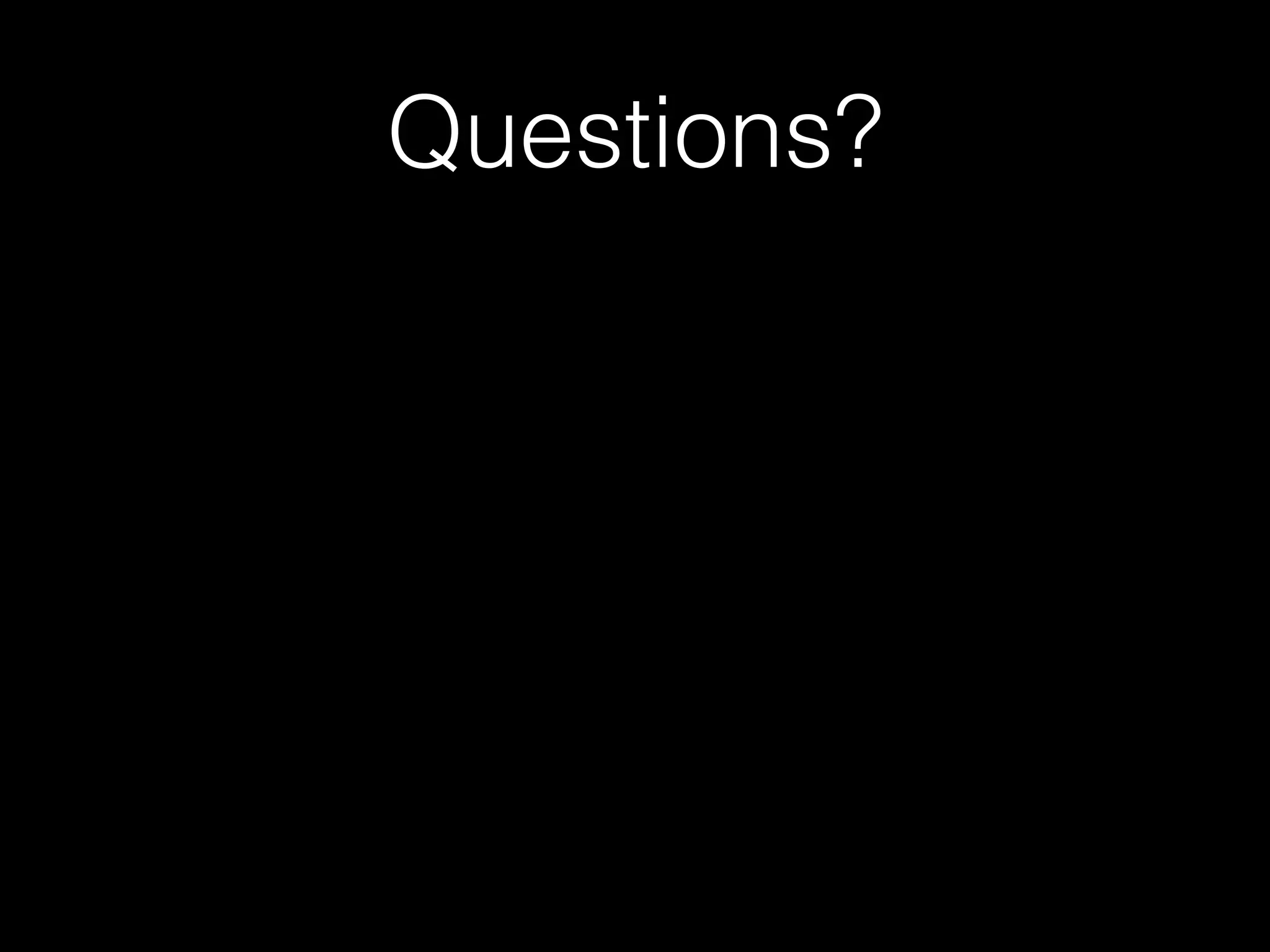


![Selectors
UISwipeGestureRecognizer *upSwipe = [[UISwipeGestureRecognizer alloc]
initWithTarget:self action:@selector(upButtonTapped)];
!
upSwipe.numberOfTouchesRequired = 1;
upSwipe.direction = UISwipeGestureRecognizerDirectionUp;
[self.view addGestureRecognizer:upSwipe];
!
!
!
- (void)upButtonTapped {
[self.model performMoveInDirection:F3HMoveDirectionUp
completionBlock:^(BOOL changed) {
if (changed) [self followUp]; }];
}](https://image.slidesharecdn.com/swiftpresentation-1-140723181949-phpapp02/75/Swift-via-swift-2048-43-2048.jpg)
![Selectors
UISwipeGestureRecognizer *upSwipe = [[UISwipeGestureRecognizer alloc]
initWithTarget:self action:@selector(upButtonTapped)];
!
upSwipe.numberOfTouchesRequired = 1;
upSwipe.direction = UISwipeGestureRecognizerDirectionUp;
[self.view addGestureRecognizer:upSwipe];
!
!
!
- (void)upButtonTapped {
[self.model performMoveInDirection:F3HMoveDirectionUp
completionBlock:^(BOOL changed) {
if (changed) [self followUp]; }];
}](https://image.slidesharecdn.com/swiftpresentation-1-140723181949-phpapp02/75/Swift-via-swift-2048-44-2048.jpg)
![Selectors
UISwipeGestureRecognizer *upSwipe = [[UISwipeGestureRecognizer alloc]
initWithTarget:self action:@selector(upButtonTapped)];
!
upSwipe.numberOfTouchesRequired = 1;
upSwipe.direction = UISwipeGestureRecognizerDirectionUp;
[self.view addGestureRecognizer:upSwipe];
!
!
!
- (void)upButtonTapped {
[self.model performMoveInDirection:F3HMoveDirectionUp
completionBlock:^(BOOL changed) {
if (changed) [self followUp]; }];
}](https://image.slidesharecdn.com/swiftpresentation-1-140723181949-phpapp02/75/Swift-via-swift-2048-45-2048.jpg)
![Selectors
UISwipeGestureRecognizer *upSwipe = [[UISwipeGestureRecognizer alloc]
initWithTarget:self action:@selector(upButtonTapped)];
!
upSwipe.numberOfTouchesRequired = 1;
upSwipe.direction = UISwipeGestureRecognizerDirectionUp;
[self.view addGestureRecognizer:upSwipe];
!
!
!
- (void)upButtonTapped {
[self.model performMoveInDirection:F3HMoveDirectionUp
completionBlock:^(BOOL changed) {
if (changed) [self followUp]; }];
}](https://image.slidesharecdn.com/swiftpresentation-1-140723181949-phpapp02/75/Swift-via-swift-2048-46-2048.jpg)




